Few landscaping features greet guests as warmly as a thoughtfully designed front walkway. Beyond guiding footsteps, a path can echo your home’s architecture, buffer plant beds, and even recharge groundwater when built with permeable joints. Flagstone, brick, concrete, gravel, wood, and high-tech aggregates each bring specific strengths, allowing you to tailor maintenance, slip-resistance, and storm-water performance. Recent advances—like photoluminescent stones that glow for up to fifteen hours after dusk—add safety without wiring. Explore twenty inspiring front walkway ideas that balance everyday practicality with eye-catching style, then customize the details to fit climate, budget, and personality.
1. Curved Flagstone Walkway for Organic Flow
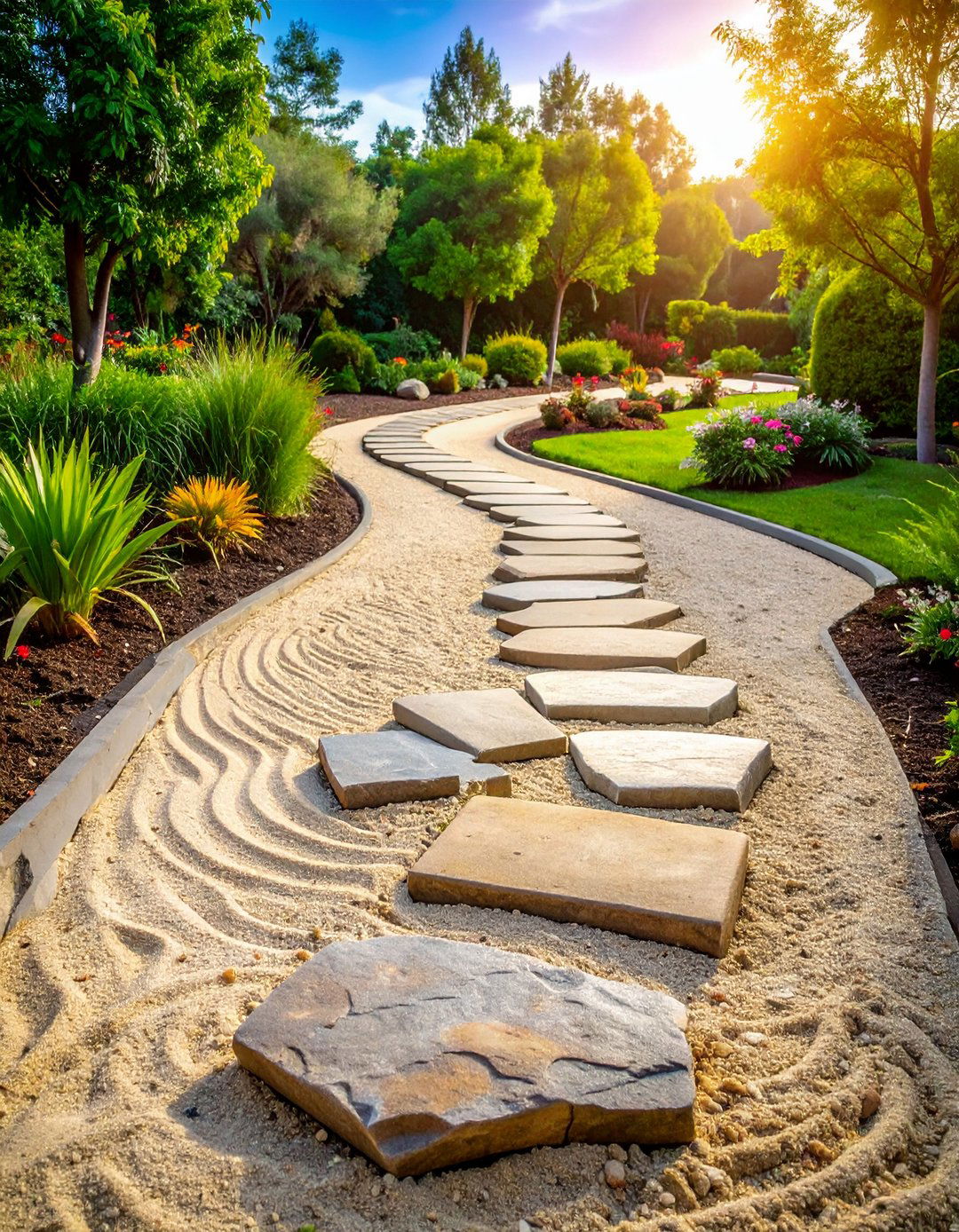
A gently curving flagstone walkway instantly softens hard architecture and encourages a slower, more scenic approach to the door. By dry-laying irregular slabs on a compacted sand bed, rainwater filters through joints instead of rushing toward storm drains, reducing runoff and helping nearby plantings thrive. Because flagstone is naturally textured, the surface stays grippy even when wet, making it family- and pet-friendly year-round. Choose locally quarried stone where possible to keep color palettes harmonious and transportation impacts low, then widen the curve on wider lawns for mower access. Finish by sweeping stone dust into the gaps to lock pieces yet allow breathing room for seasonal frost heave.
2. Illuminated Walkway with Low-Voltage Lights

Safety meets ambiance when a front walkway is edged with low-voltage LED path lights spaced roughly six to eight feet apart. The fixtures cast a downward pool that prevents glare, highlights plant textures, and quietly points guests toward the entry after dark. Running on a 12-volt transformer, the system sips energy and can be connected to photo-cell timers so it activates automatically at dusk. Select warm-white bulbs (2700–3000 K) to flatter stone colors, and stagger fixtures from side to side rather than lining them up like a runway for a more natural rhythm. Leave conduit slack at curves for easy bulb replacement and future plant growth.
3. Mixed-Material Walkway Combining Pavers and Gravel
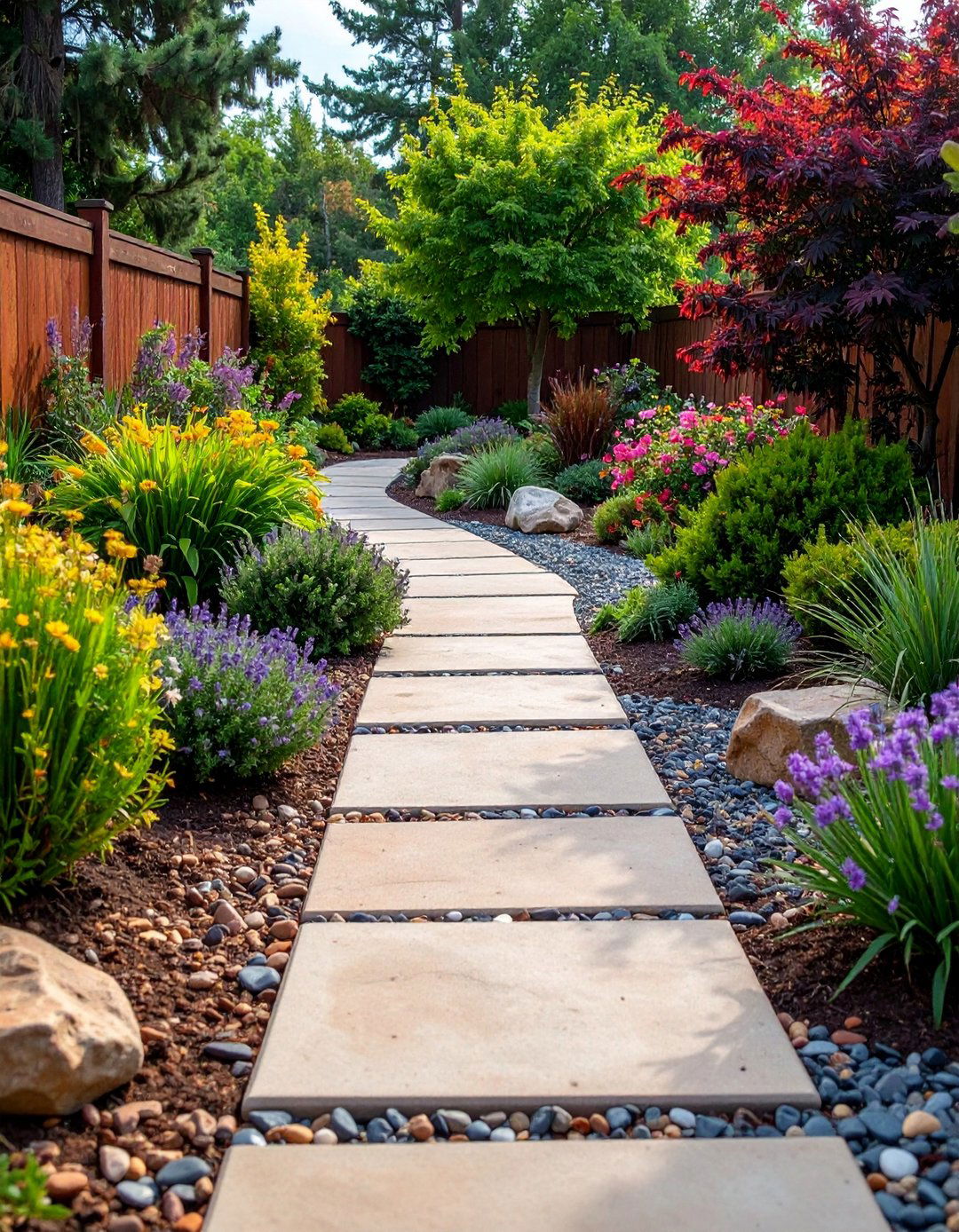
Blending concrete pavers with decorative gravel creates a front walkway that feels crafted yet cost-savvy. Start by setting large pavers in a checkerboard or running-bond pattern, leaving two- to four-inch gaps that you later fill with contrasting stone chips. This mixed approach lowers material costs, speeds drainage, and lets you echo roof or siding colors through gravel selection. Keep the pavers perfectly level so luggage wheels roll smoothly, then rake the loose aggregate every few weeks to maintain a tidy surface. In snowy climates, choose angular gravel rather than round pea stone to resist scattering under shovel blades and reduce seasonal maintenance.
4. Stepping-Stone Walkway Nestled in Groundcovers
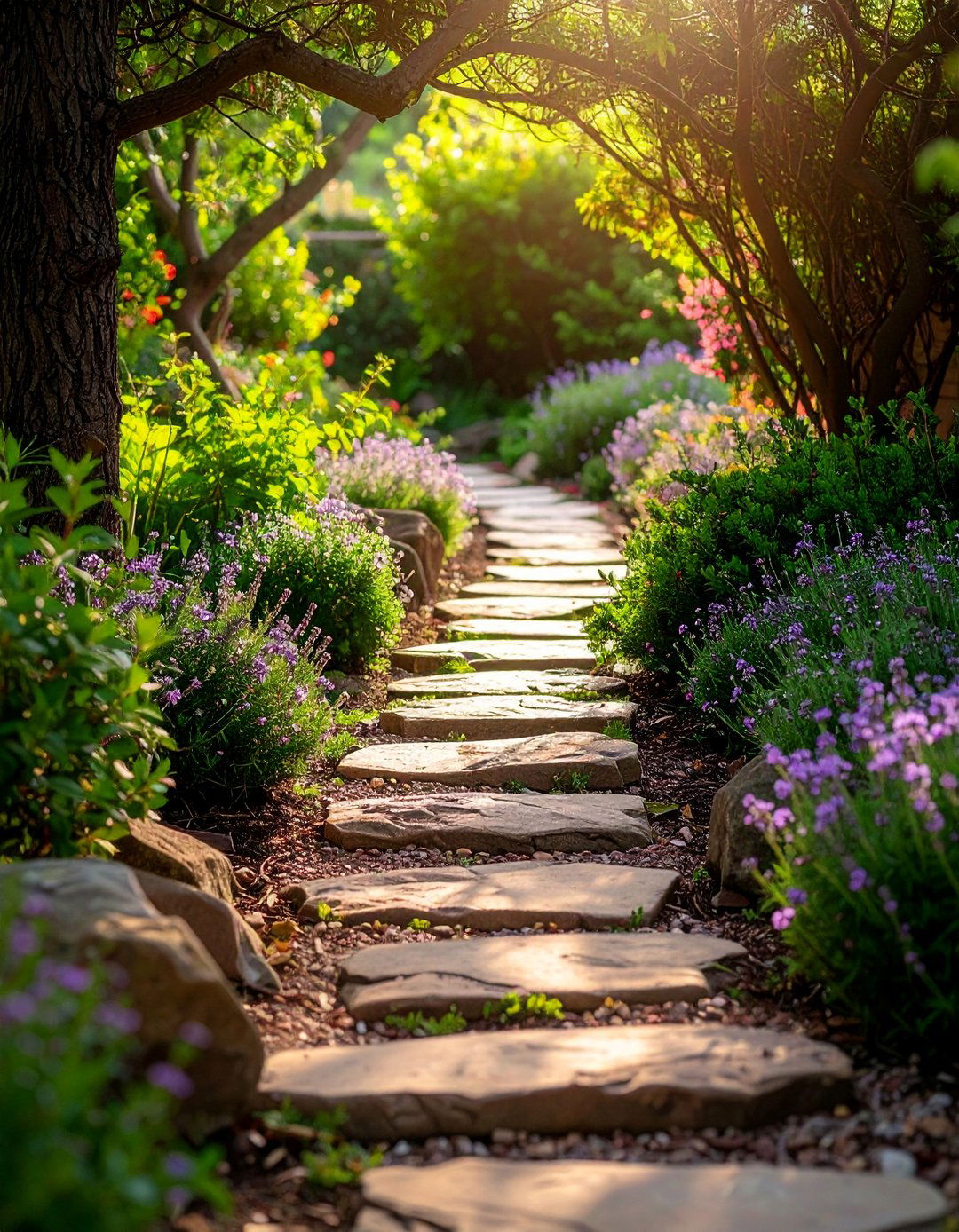
Where lawn struggles beneath trees, swap turf for a stepping-stone walkway cushioned by low-growing groundcovers. Flat stones set flush with soil allow mower blades to glide over edges, while carpeting plants like creeping thyme or blue star creeper quickly knit between joints, choking out weeds and perfuming the air when brushed. Keep spacing comfortable—about a stride apart—and vary stone shapes so each hop feels deliberate, slowing visitors to enjoy dappled shade. Use a three-inch layer of crushed gravel beneath stones to prevent shifting, then top-dress with compost to feed the living green grout. Mulching lightly until coverage fills in keeps moisture steady during the first growing season.
5. Sleek Concrete Slab Walkway for Modern Homes
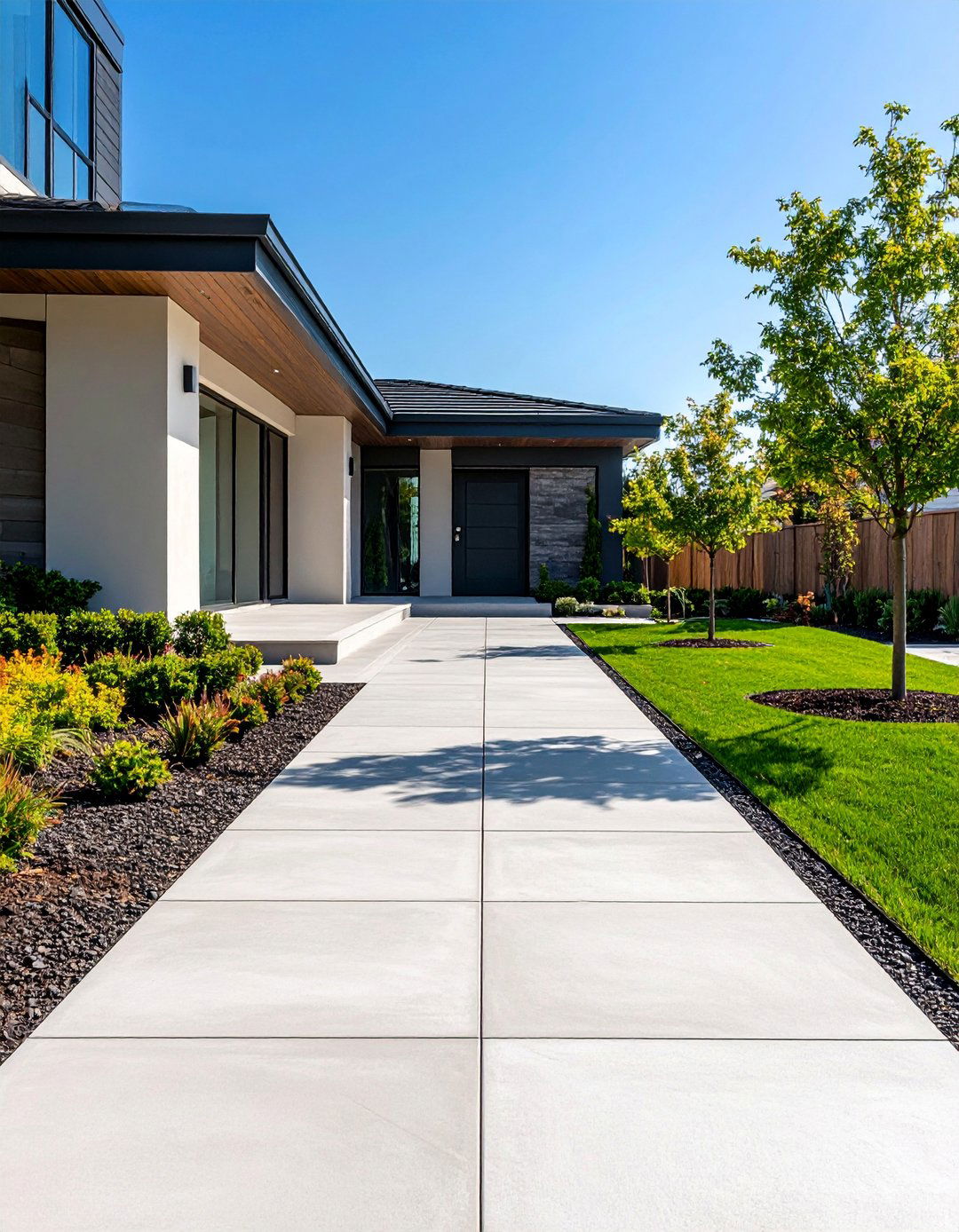
Large-format concrete slabs poured in clean rectangles create a minimalist walkway that plays well with contemporary façades and low-profile plantings. A slight bevel on the edges prevents chipping, while broom finishing delivers enough texture to meet slip-resistance codes. Score shallow expansion joints every four to six feet to control cracking, or alternate poured pads with lawn strips to visually elongate a tight frontage. Tint the mix with integral pigment that echoes window trim so the walkway looks intentional rather than after-thought. Seal once the surface cures to guard against de-icing salts, then sweep quarterly to keep its crisp geometry in focus.
6. Mosaic Tile Walkway Showcasing Artistic Flair
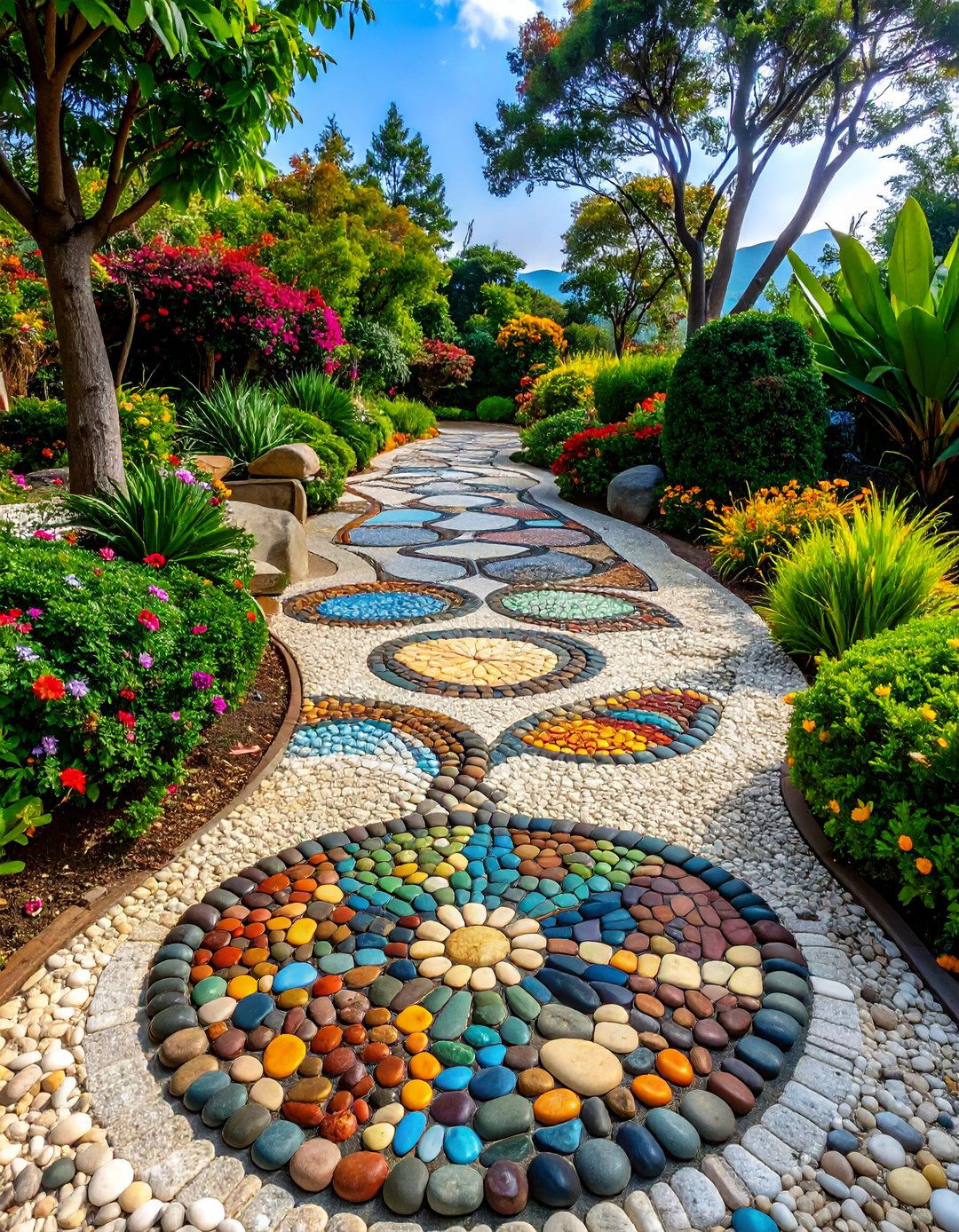
Inject personality by embedding a pebble or ceramic mosaic into a concrete base to form a walkway that doubles as artwork. Laying small stones or broken tiles into wet mortar lets you craft waves, spirals, or initials without needing special tools, and the tight joints create a flat, stroller-friendly surface. Choose color bands that echo door paint or seasonal planting schemes so the path feels cohesive. Because mosaics draw the eye downward, keep surrounding beds simple—think evergreen hedges or mulch—to avoid visual clutter. Finally, apply a penetrating sealer once fully cured to protect grout from freeze-thaw cycles and make future cleaning a quick hose rinse.
7. Timber Boardwalk-Style Walkway Over Soft Soil
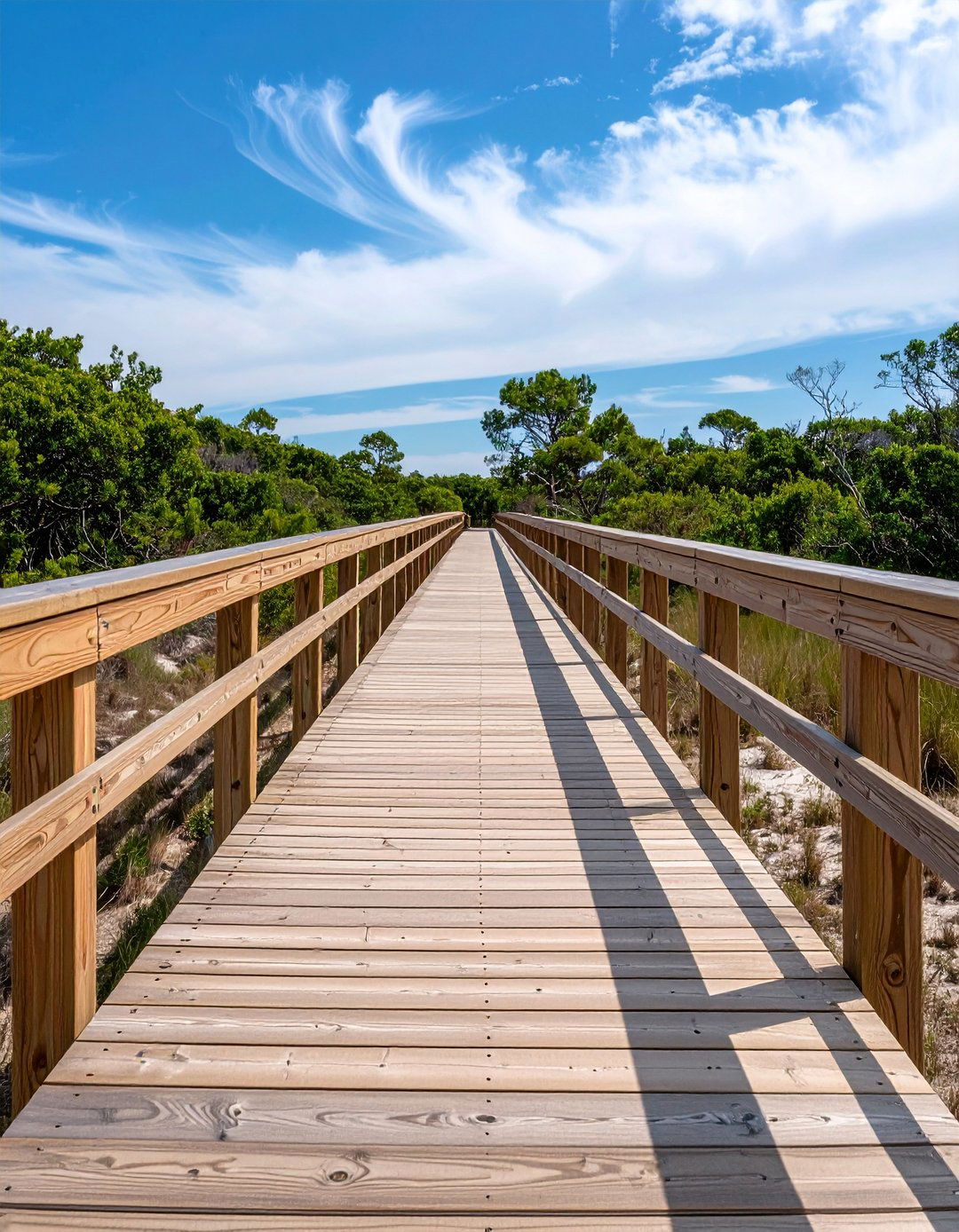
If your front yard stays spongy after rain, raise the route on timber sleepers to create a small-scale boardwalk walkway. Pressure-treated or naturally rot-resistant wood such as cedar sits on hidden joists, letting air circulate under planks and preventing muddy boots. Space boards a quarter-inch apart to shed water and allow fallen leaves to blow through. For extra grip, mill shallow grooves across each plank or staple on coarse sandpaper strips where ice forms. Finish with a plant-safe, low-VOC stain that matches the porch rails, then underplant with moisture-loving ferns to blur edges and give the path a woodland vibe.
8. Permeable Paver Walkway Enhancing Drainage
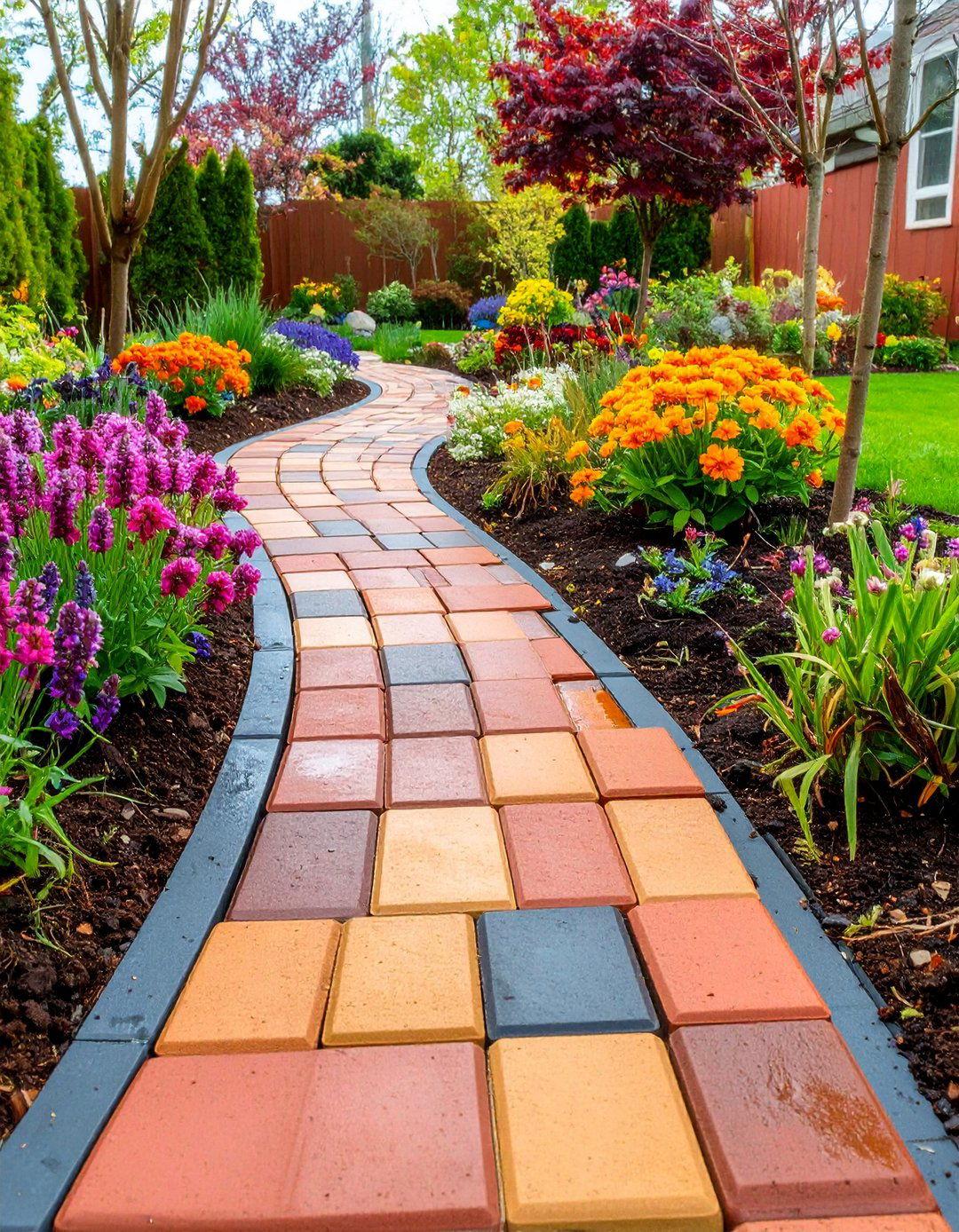
A permeable paver walkway uses blocks with open joints or lattice-style voids that let stormwater pass through into a base of washed stone, easing pressure on municipal drains and reducing ice sheets. These systems can capture up to 90 percent of runoff when correctly installed on a graded sub-base, making them smart for flood-prone suburbs. The pavers themselves come in earthy tones or crisp charcoal, so you can match architectural trim without sacrificing function. Vacuum out infill gravel every couple of years and top up fresh aggregate to keep pores clear. In winter, apply sand instead of salt—permeable pavements melt faster because stored water drains away.
9. Classic Brick Herringbone Walkway with Charm
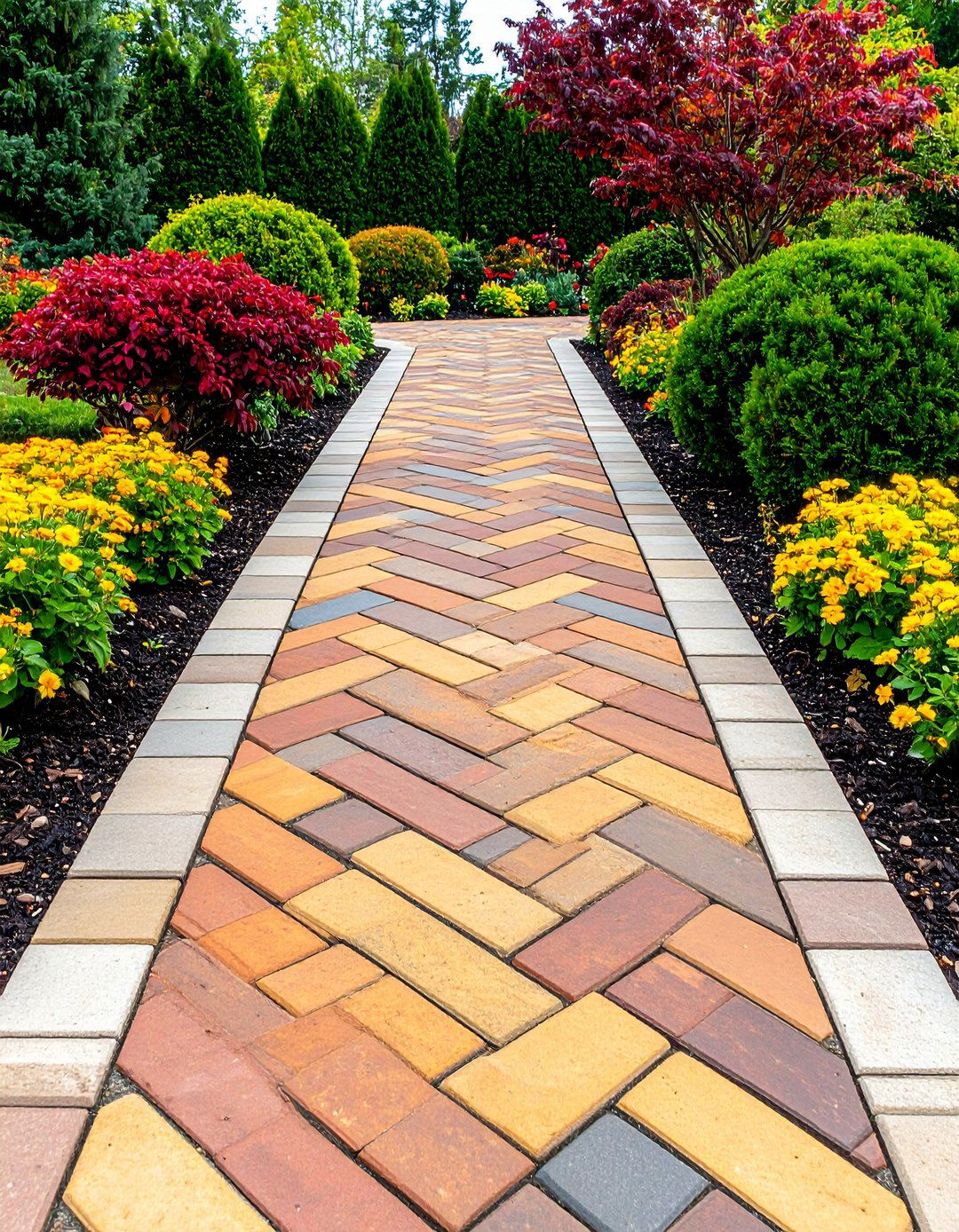
A brick herringbone walkway evokes timeless charm and stands up well to traffic thanks to its interlocking pattern, which resists movement from frost or lawn roots. Lay full-depth clay bricks on a six-inch compacted gravel base, setting the first row perpendicular to the house to establish straight lines. Edge the path with soldier-course bricks set on edge to hold the field tight and add a finished look. Because clay retains color through the body, scratches from snow shovels won’t expose lighter cores. Seal with a breathable, siloxane-based product to repel stains while letting moisture escape, and sweep polymeric sand into joints to deter ants.
10. Cottage-Style Crushed Gravel Walkway
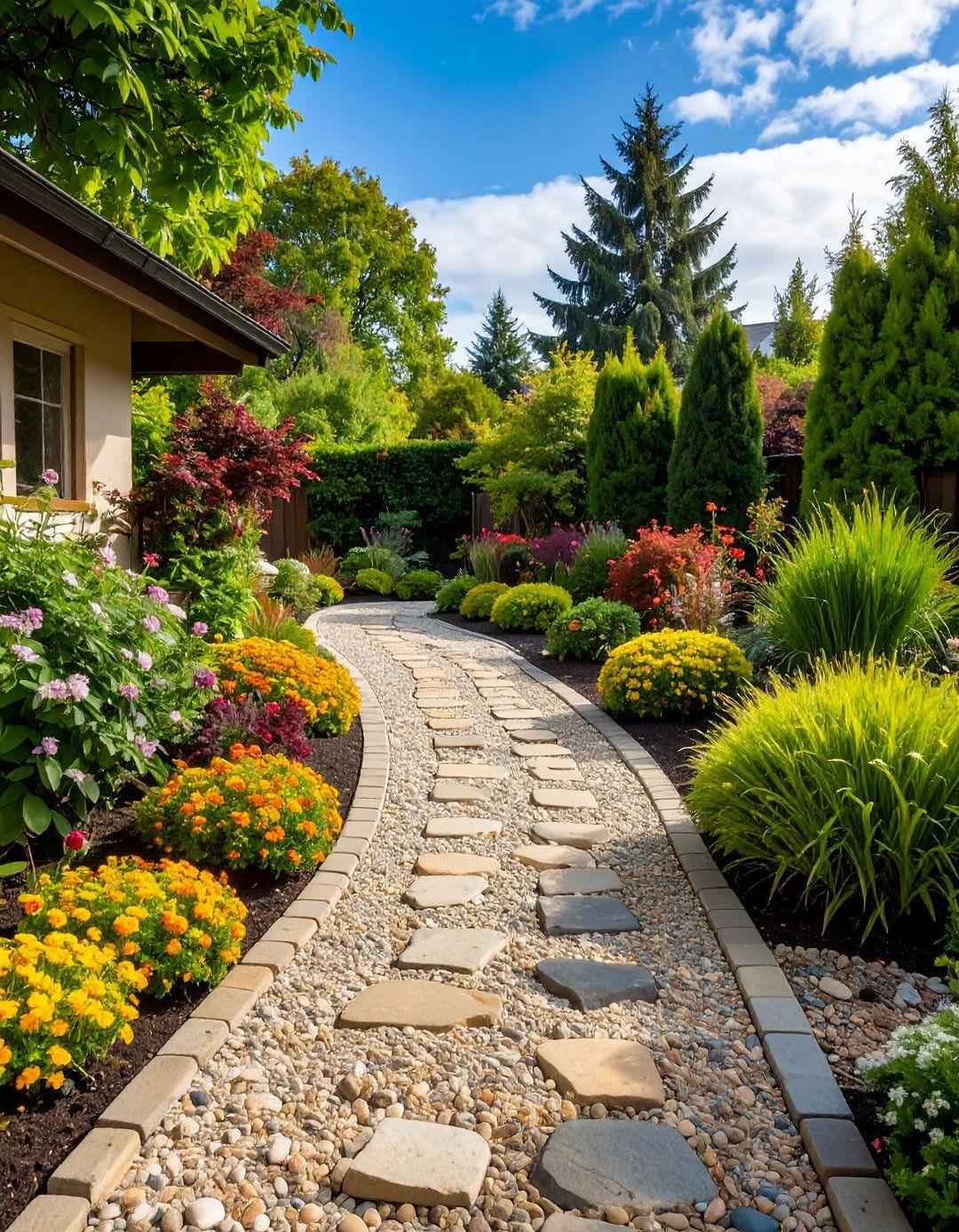
A cottage gravel walkway crunches pleasantly underfoot and adapts to informal garden borders filled with herbs and blooms. Crushed rock’s angular edges interlock to produce a firm, wheelchair-friendly surface while still allowing rain to filter through, improving drainage and reducing puddles. Spread a three-inch layer over landscape fabric to block weeds, then frame edges with steel, brick, or cedar bender board to keep stones in place. Because gravel is low maintenance, seasonal upkeep amounts to raking displaced pieces back into line and topping up every few years. Choose locally quarried tan or gray stone to harmonize with native soils for a natural look.
11. Border-Planting Walkway Framed by Perennials
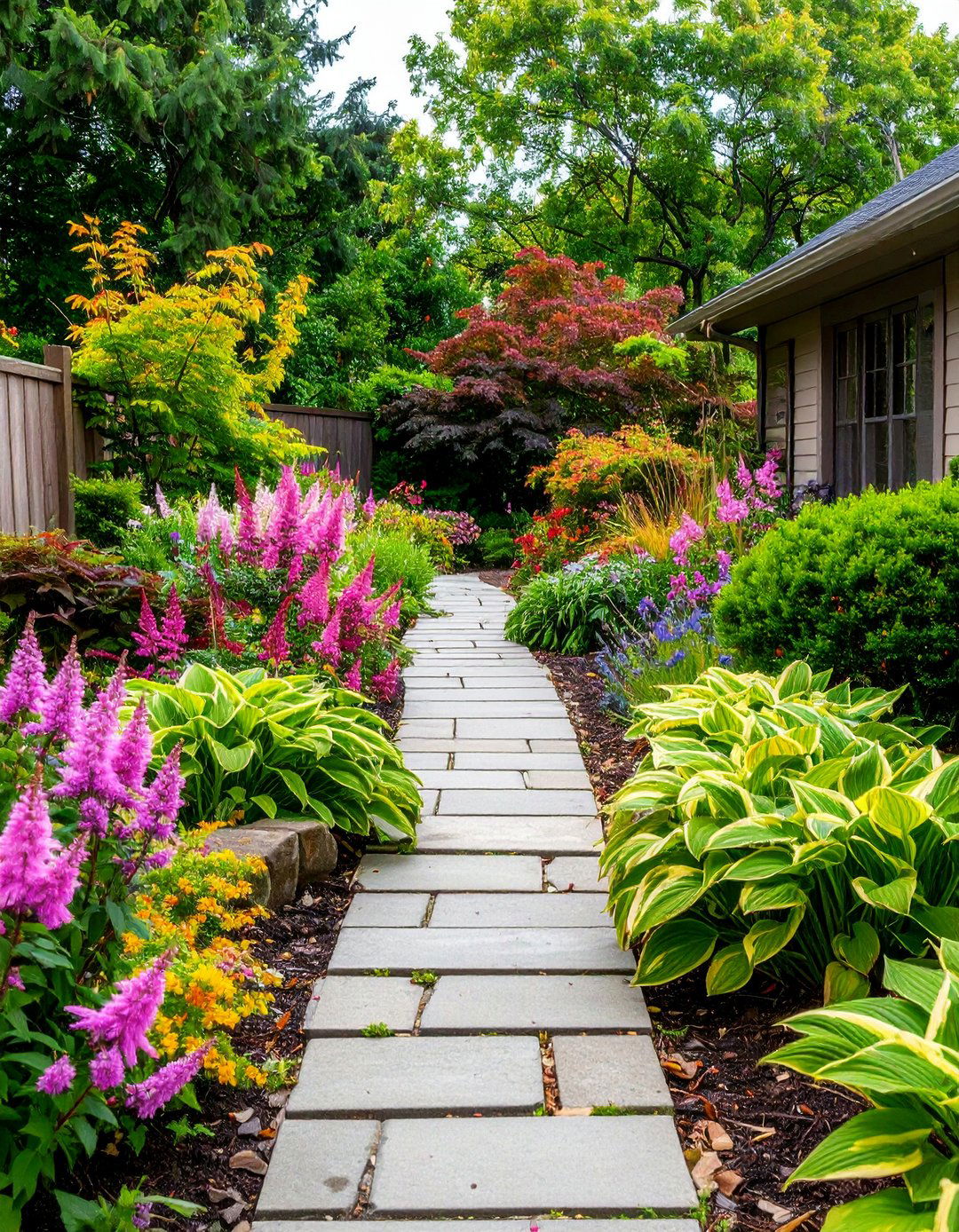
Flank a straight front walkway with ribbon-like beds of shade-tolerant perennials to create a living frame that changes through the seasons. Clumps of hosta, astilbe, and hellebore soften hard paving and supply low maintenance color in dappled light. Curve the bed edges slightly inward near the midpoint to make the path appear longer, then repeat foliage shapes for cohesion. Keep taller plants toward the house wall so the view remains open from the street, and install drip irrigation under mulch so watering chores stay invisible. Refresh mulch annually to tidy edges and insulate roots, ensuring the walkway remains welcoming even in midsummer heat.
12. Walkway with Built-In Seating Nooks
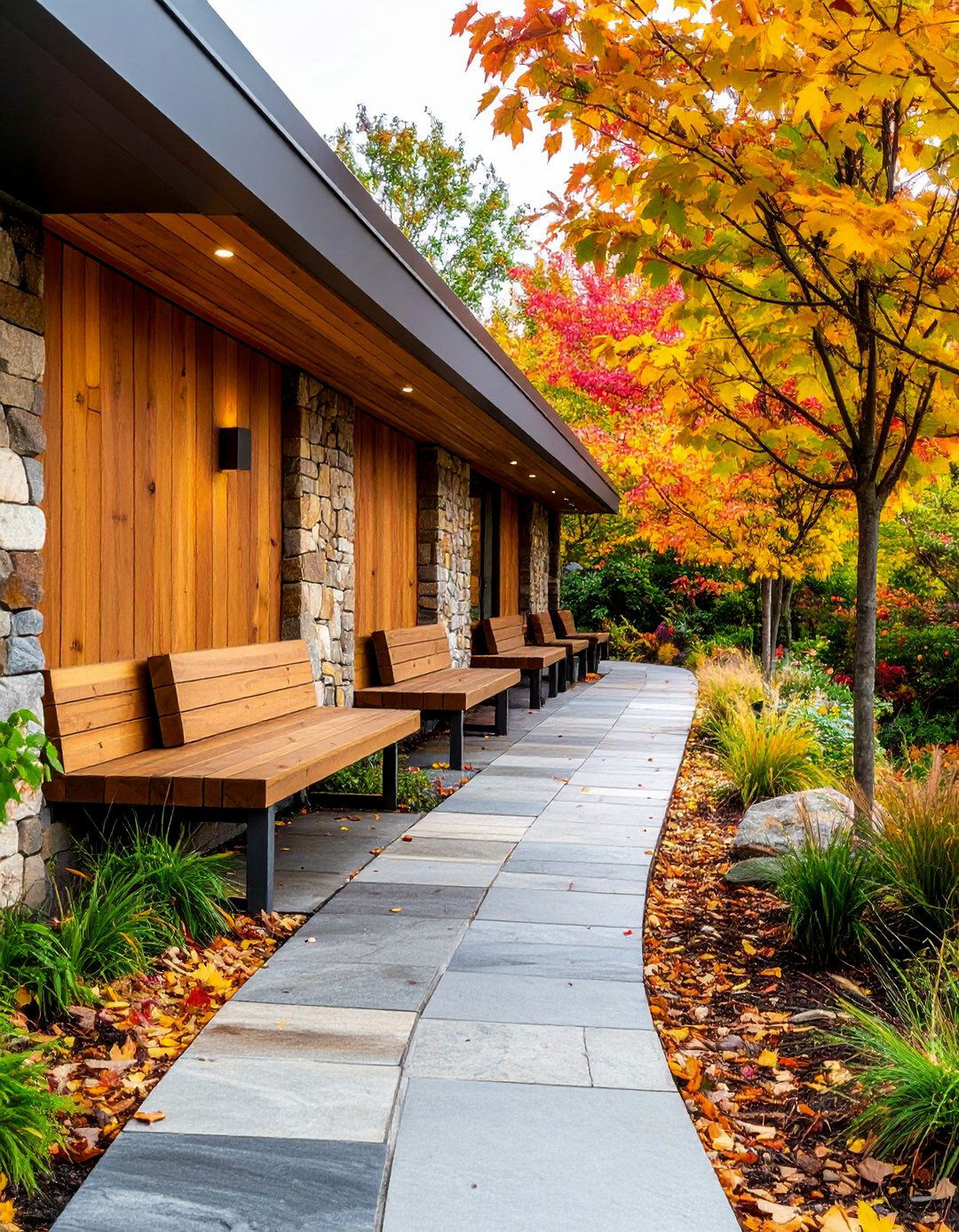
Introducing stone or timber seat walls along a front walkway invites neighbors to linger and provides a handy perch for groceries or boots. Recent parklet projects show that combining benches with permeable gravel paths can turn even compact spaces into social zones. Build seat walls 18-inches high with a gentle 2-inch slope on the capstone for drainage, and keep them three feet back from the path’s centerline to preserve clear passage. Top cushions aren’t mandatory; a smooth flagstone cap feels comfortable and matches paving. Layer aromatic herbs like lavender behind the bench to disguise mortar joints and add fragrance. Solar path lights tucked beneath the seat overhang double as subtle footwell illumination.
13. Geometric Pattern Walkway Using Square Pavers
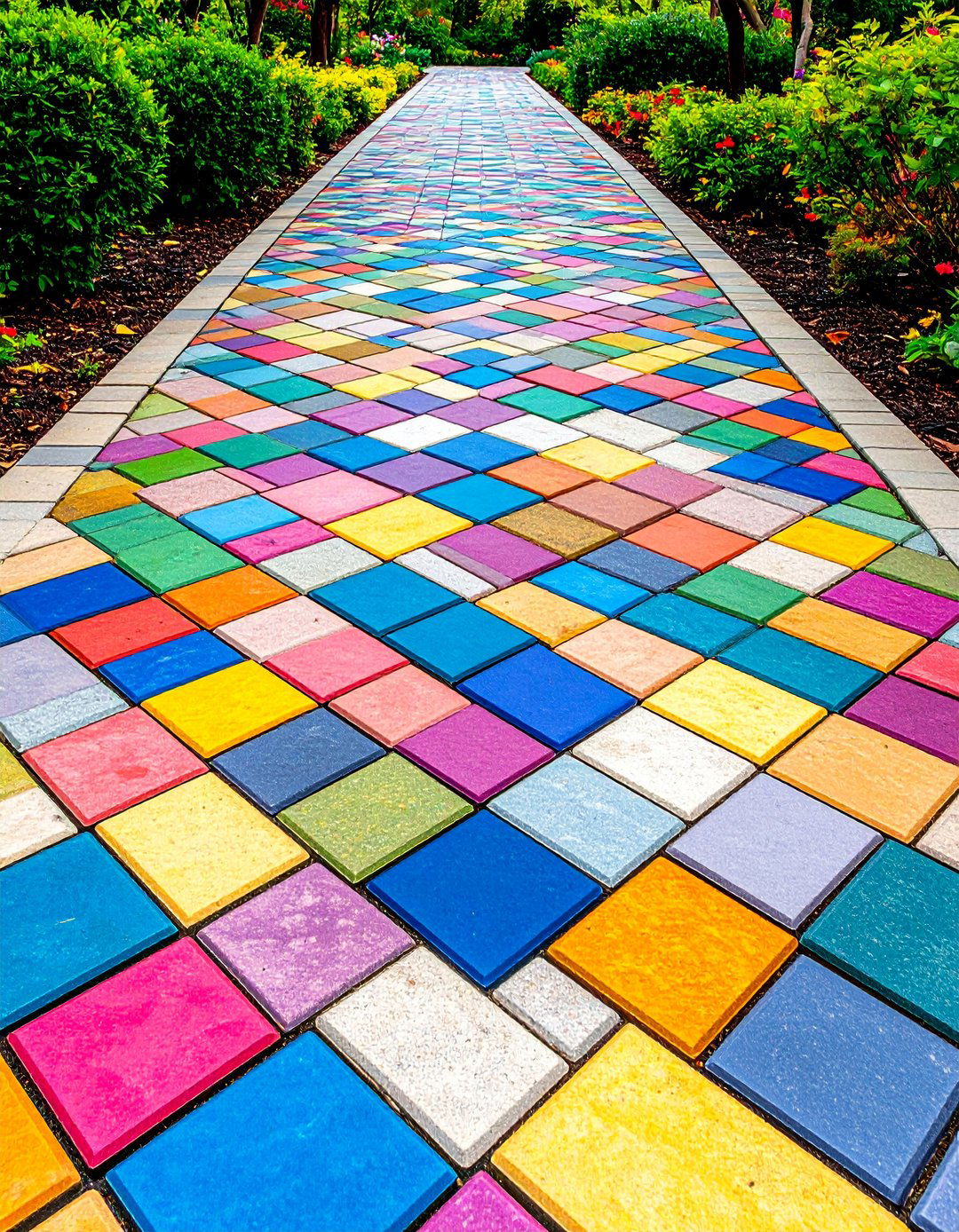
Square concrete or stone pavers arranged in alternating orientations create a geometric walkway that feels fresh but easy to lay. Place 16- or 18-inch squares corner to corner to form diamonds, then accent every third joint with a contrasting colored tile for a subtle graphic punch. This pattern works well on narrow lots because the diagonal lines visually widen the approach. Keep joints consistent at three-eighths inch and fill with polymeric sand to deter weeds. Because pieces are modular, you can lift and re-set individual squares if tree roots push up over time, making long-term maintenance simple. Choose a light-absorbing finish on pavers to reduce glare in sunny climates.
14. Recycled Glass Aggregate Walkway for Sustainability

Swap a portion of traditional sand in concrete for recycled glass aggregate to craft a walkway that sparkles in sunlight and lowers the project’s carbon footprint. Glass chips reduce the amount of cement needed, cutting embodied CO₂ and giving new life to household waste. The particles also increase abrasion resistance, meaning fewer surface scratches from winter grit. Ask your ready-mix supplier for consistent particle size—about 3⁄8-inch—so the finish remains smooth under shoes. After curing, diamond-polish the surface to expose colorful glass shards, then seal with a UV-stable epoxy to keep the sparkle vivid for decades. Colored LED uplights along the edges will bounce off the aggregate at night for extra drama.
15. Walkway Lined with a Reflecting Water Rill
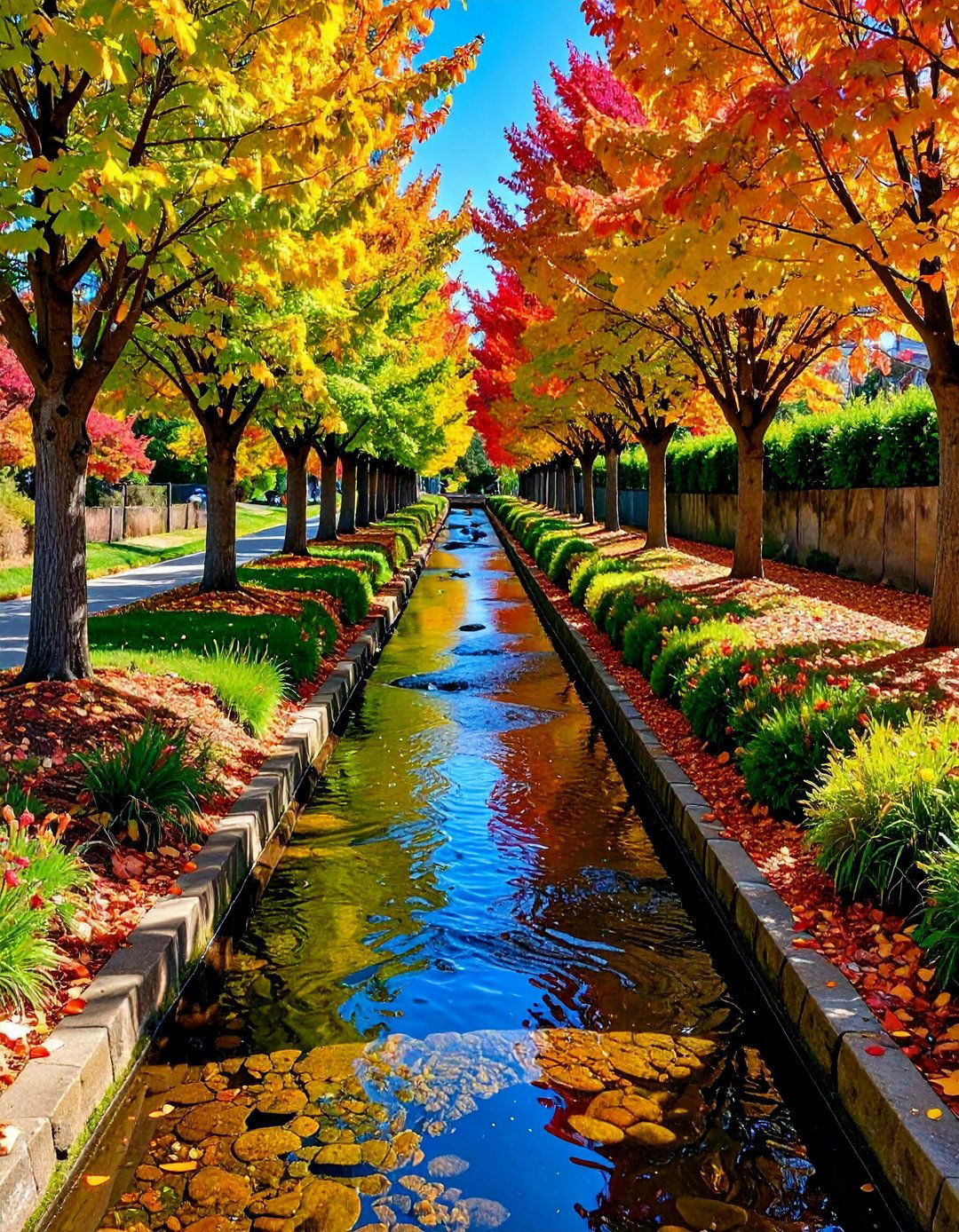
Borrow a trick from formal gardens by running a shallow, nine-inch-wide rill parallel to your walkway, turning each arrival into a sensory experience of moving water and mirrored sky. Even a half-inch depth is enough to sparkle, and the gentle flow masks street noise. Use a hidden pump and basin at the low end so water recirculates, keeping utility costs minimal. Edge the rill with stainless or stone coping flush with the paving to prevent trips, and install low-voltage strip lights beneath the water for nighttime shimmer. Add floating pads of water lettuce in summer, leaving clear space at bends for easy skimming.
16. Glow-in-the-Dark Walkway Using Photoluminescent Stones
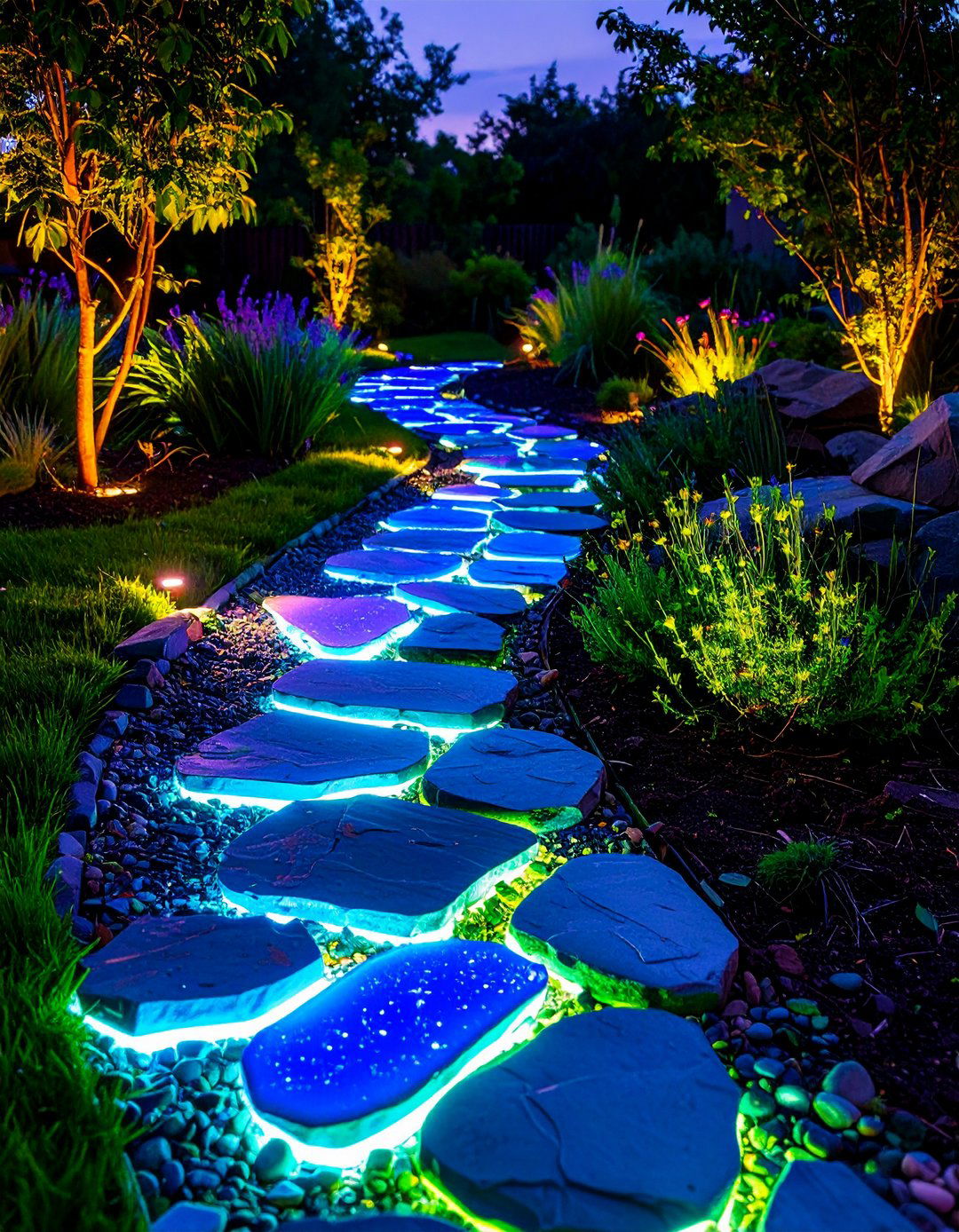
Sprinkle photoluminescent stones into a fresh top layer of clear resin or exposed aggregate to produce a walkway that charges in daylight and glows up to fifteen hours after sunset—no wiring required. The strontium-based pigment is non-toxic and lasts more than twenty years, making it a low-maintenance way to mark edges for night safety. Concentrate stones along curves and steps so their glow outlines potential trip zones, and blend them with neutral gravel during the day for a subtle look. In deep shade, add a discreet solar black-light stake to boost charging where sunlight is limited. Periodic hosing keeps dust from dulling the luminescence.
17. Stamped Concrete Walkway Mimicking Natural Stone
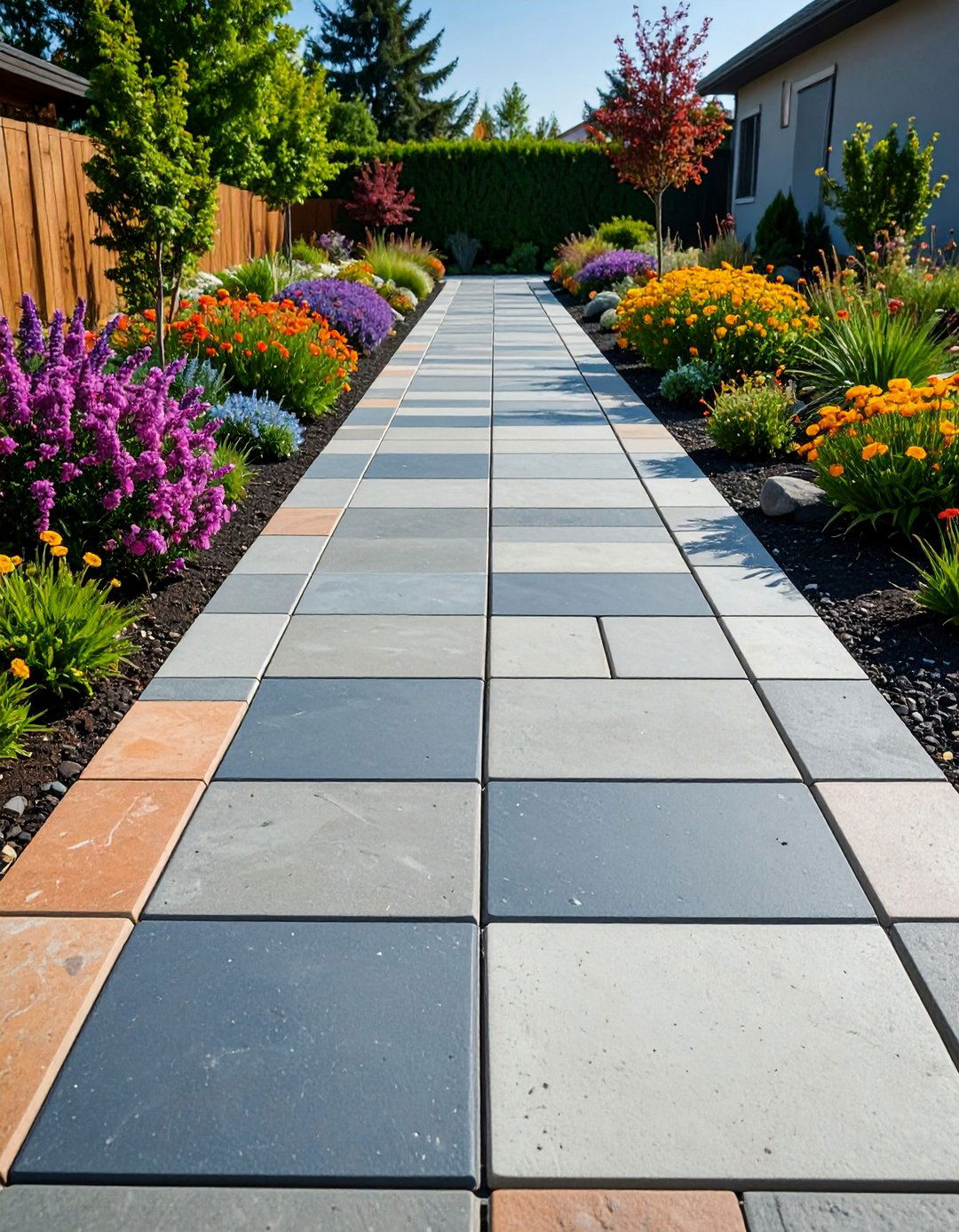
Stamped concrete lets you pour a continuous walkway while imprinting textures that echo slate, wood, or cobblestone at a fraction of the cost. Professional crews press rubber mats into fresh concrete, then dust on release powder for realistic color variation. Because the slab is monolithic, weeds can’t sprout between joints, and surface sealing every three years keeps stains at bay. For an authentic look, choose at least two accent colors—one base, one antiquing—to avoid a flat finish. Cut control joints after 24 hours to prevent random cracking, and add a broomed strip at driveway crossings for extra grip in winter. Slip-resistant additives can be mixed into the final seal coat for peace of mind.
18. Walkway with Subtle Channel Drain for Wet Climates
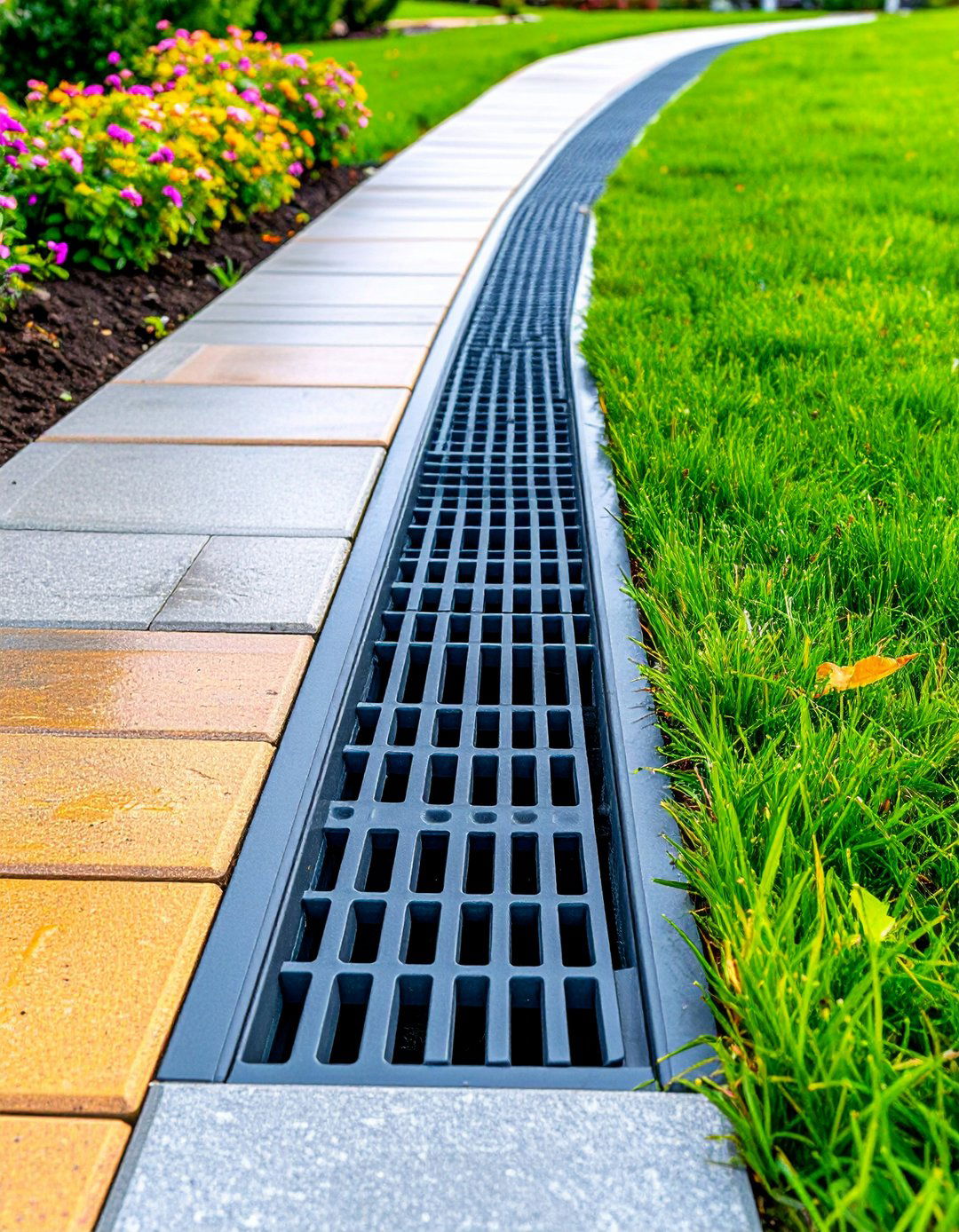
In areas that see heavy downpours, integrate a narrow channel drain down one edge of the walkway to whisk water toward a rain garden. The modular PVC system snaps together and sits flush with paving, so strollers roll smoothly while grates capture debris. Place the drain on the downhill side and set the path at a one-percent cross slope so surface water naturally finds the slot. Once a season, lift the grates and hose out sediment to maintain flow. Choose decorative cast-metal covers if the drain runs near the entry, turning a utilitarian feature into a subtle accent line. Doing so prevents puddles that can refreeze into black ice near the doorstep.
19. Trellis-Arched Walkway Leading to the Porch
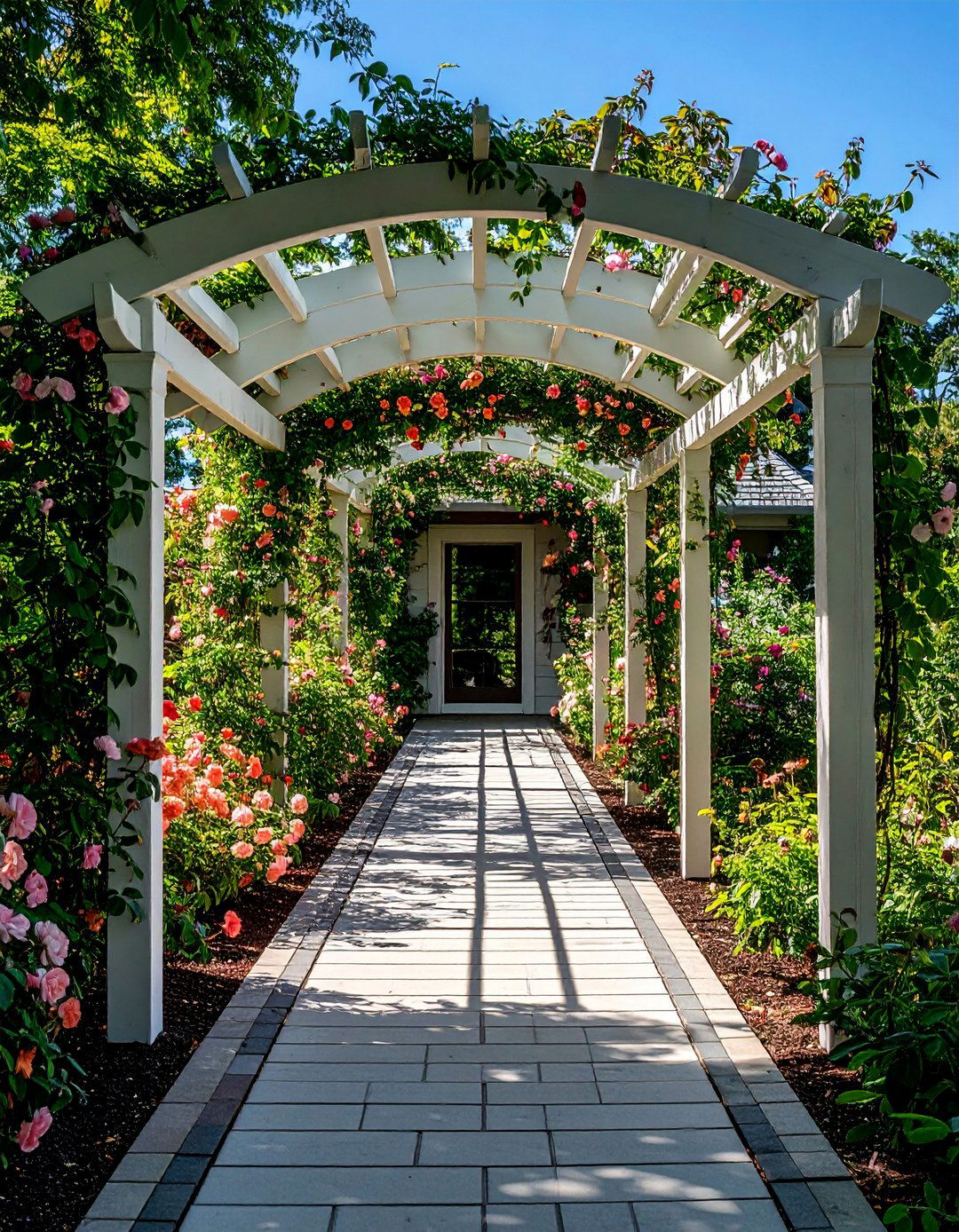
An arched trellis placed over the last few steps of a walkway frames the front door like a living picture, drawing the eye upward and adding vertical planting space. Climbing roses, jasmine, or clematis quickly cloak the structure, providing fragrance and seasonal color with minimal ground footprint. Set footings outside the pavement so roots don’t lift stones, and choose a metal or cedar frame that echoes porch hardware for cohesion. Keep interior clearance at seven feet to accommodate deliveries, and leave the first foot of stem bare to simplify pruning. LED mini-string lights woven through the lattice add subtle evening sparkle.
20. Granite Sett Walkway Accented by Boulder Edges
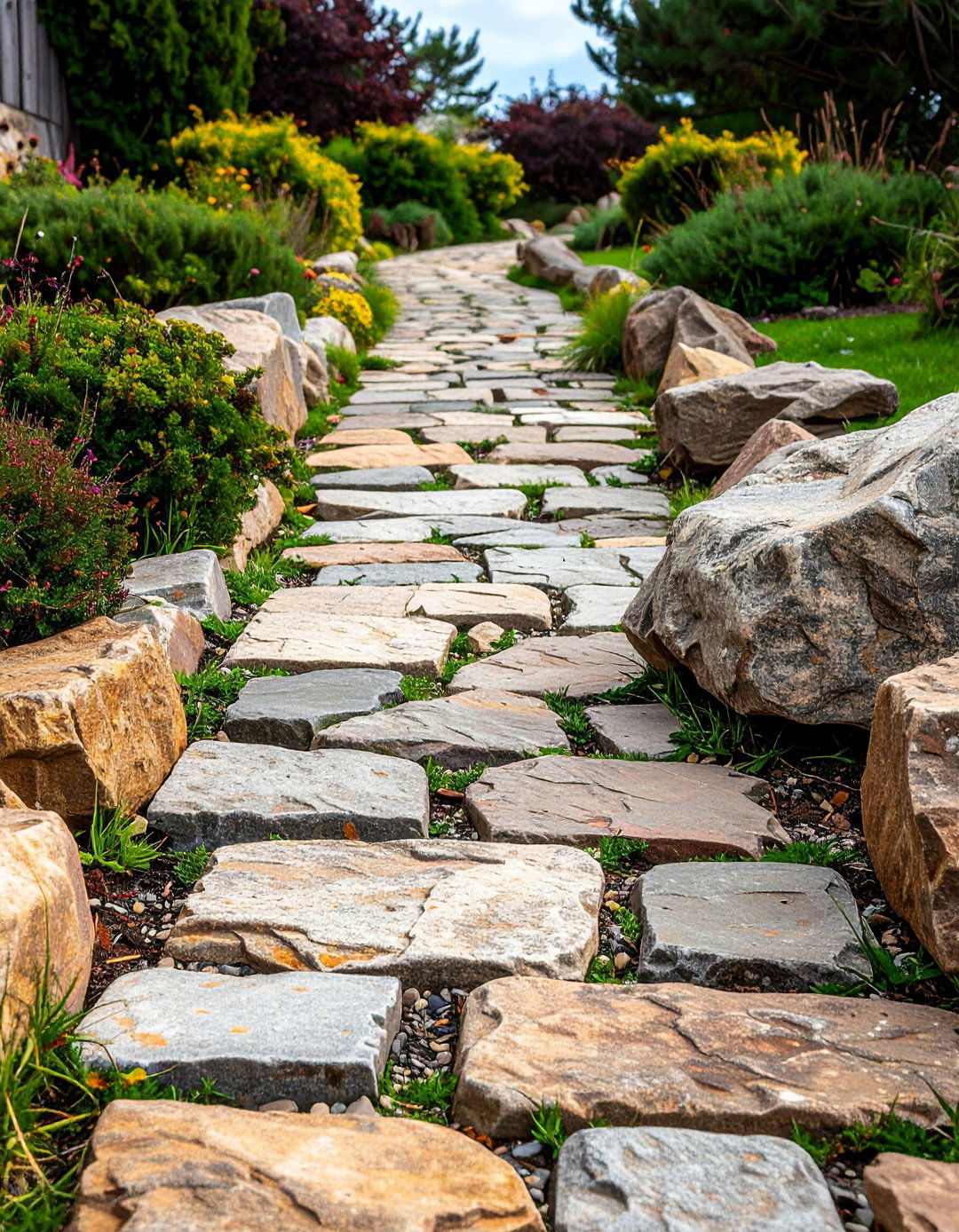
Reclaimed granite setts—small rectangular cobbles salvaged from old streets—lend historic gravitas to a front walkway and stand up to generations of foot traffic. The rugged texture offers excellent grip, and slight color variations create a hand-crafted feel impossible with uniform pavers. Bed the stones in a mix of sand and dry cement, then sprinkle water to lock joints without messy grout lines. Border the walkway with rounded fieldstone boulders set partly into the ground, echoing the quarry look while acting as subtle bollards to keep delivery vans off the edge. Annual power-washing removes moss yet leaves the desirable antique patina intact.
Conclusion:
Whether you favor the storybook crunch of gravel, the crisp geometry of concrete, or the night-glow of photoluminescent stone, each walkway idea above pairs curb appeal with practical benefits like drainage, durability, or accessibility. Start by assessing soil, climate, and the architectural language of your facade, then blend materials, lighting, and planting to guide guests comfortably from sidewalk to threshold. Remember that maintenance habits—sweeping joints, sealing surfaces, trimming vines—keep the chosen walkway concept looking fresh year after year. With thoughtful detailing, your front path becomes more than a route; it transforms into a welcoming experience that hints at the care waiting inside.


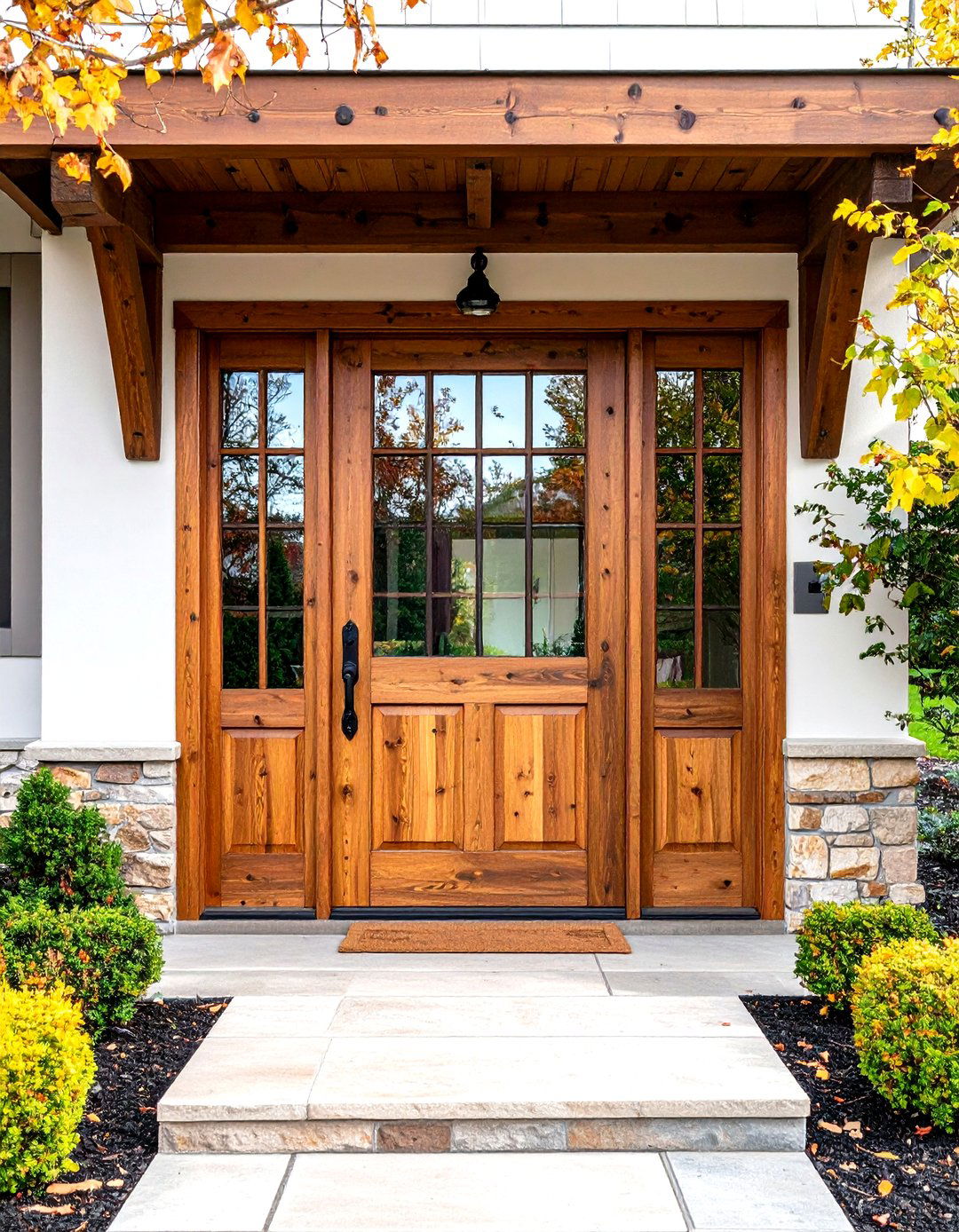

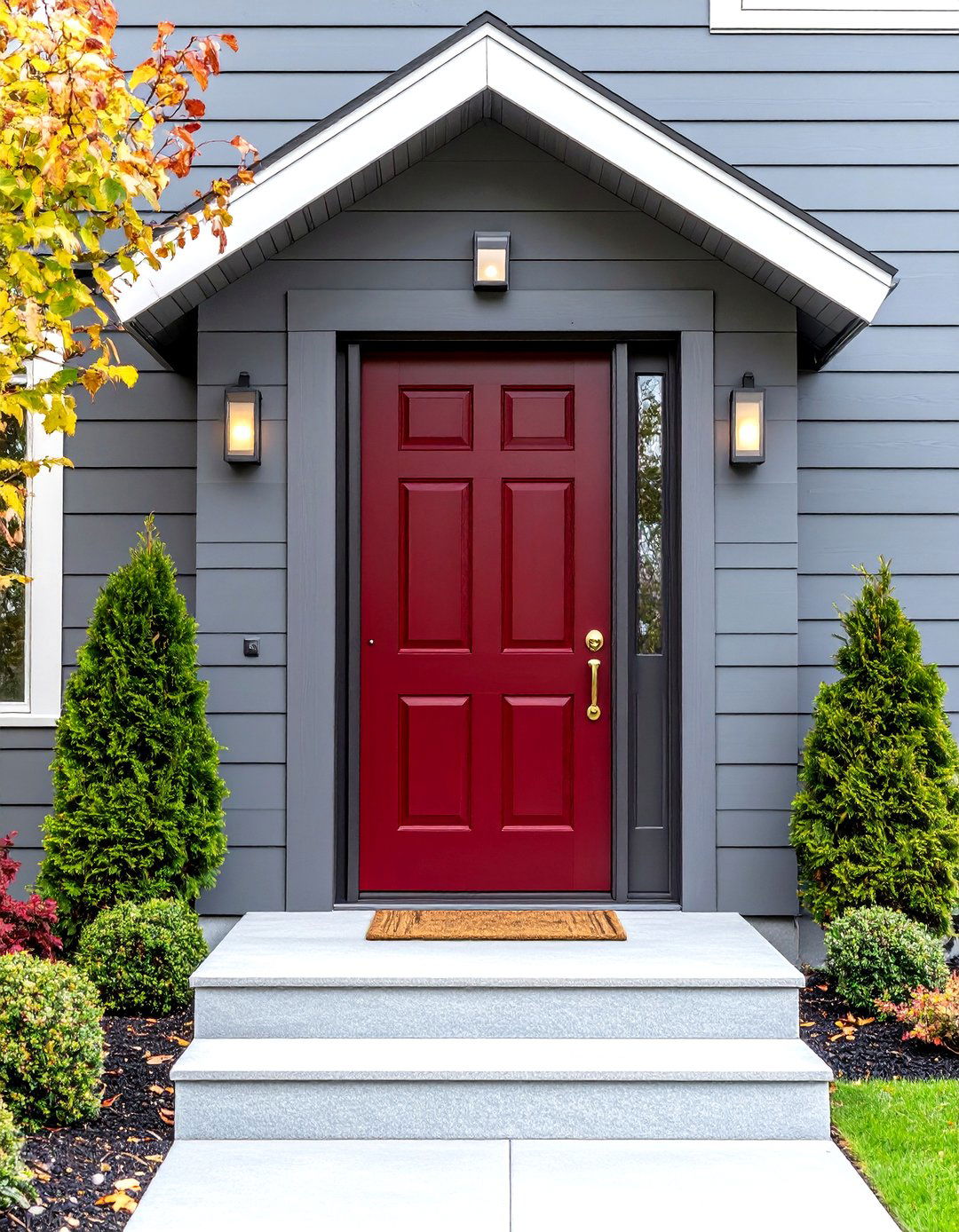
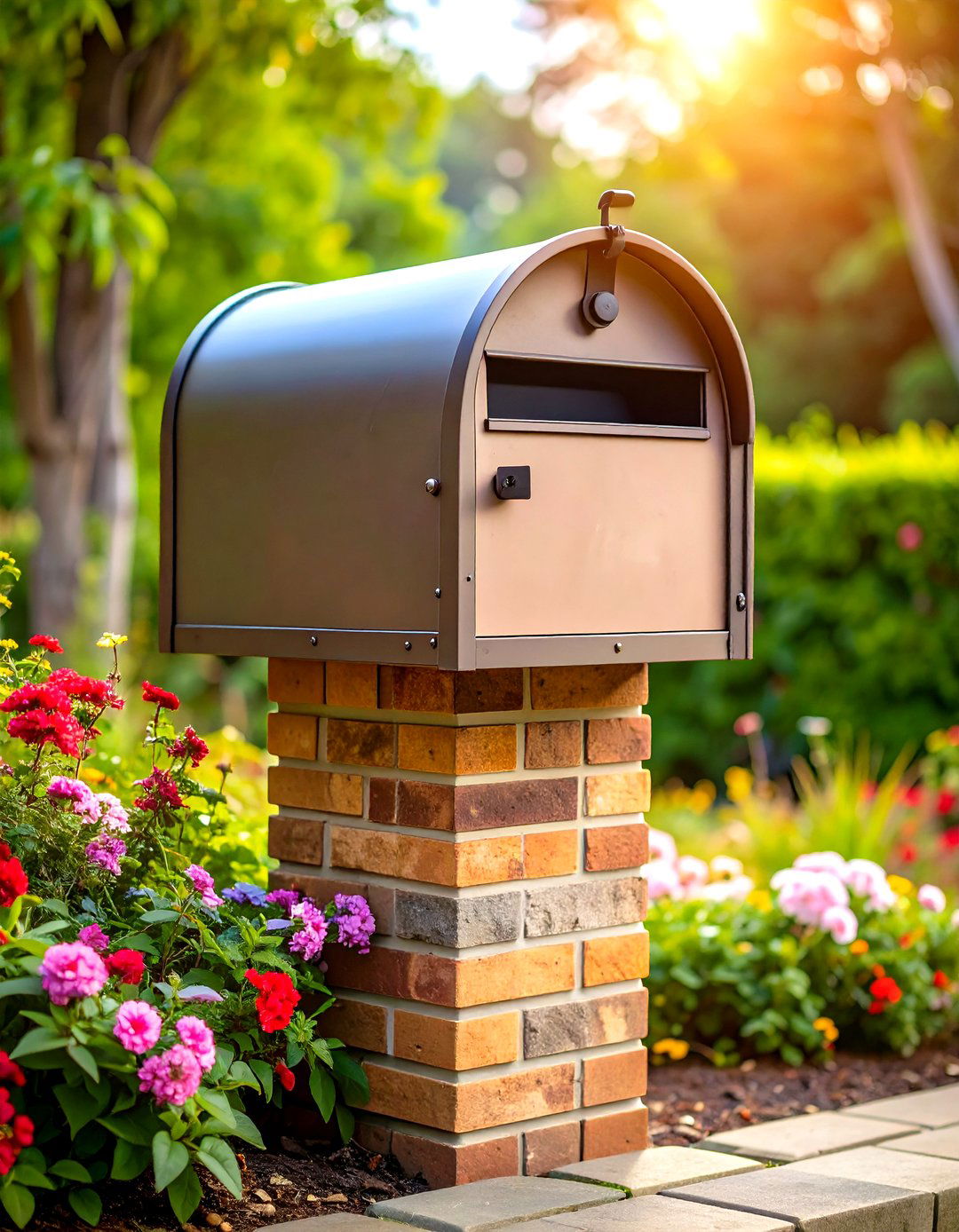
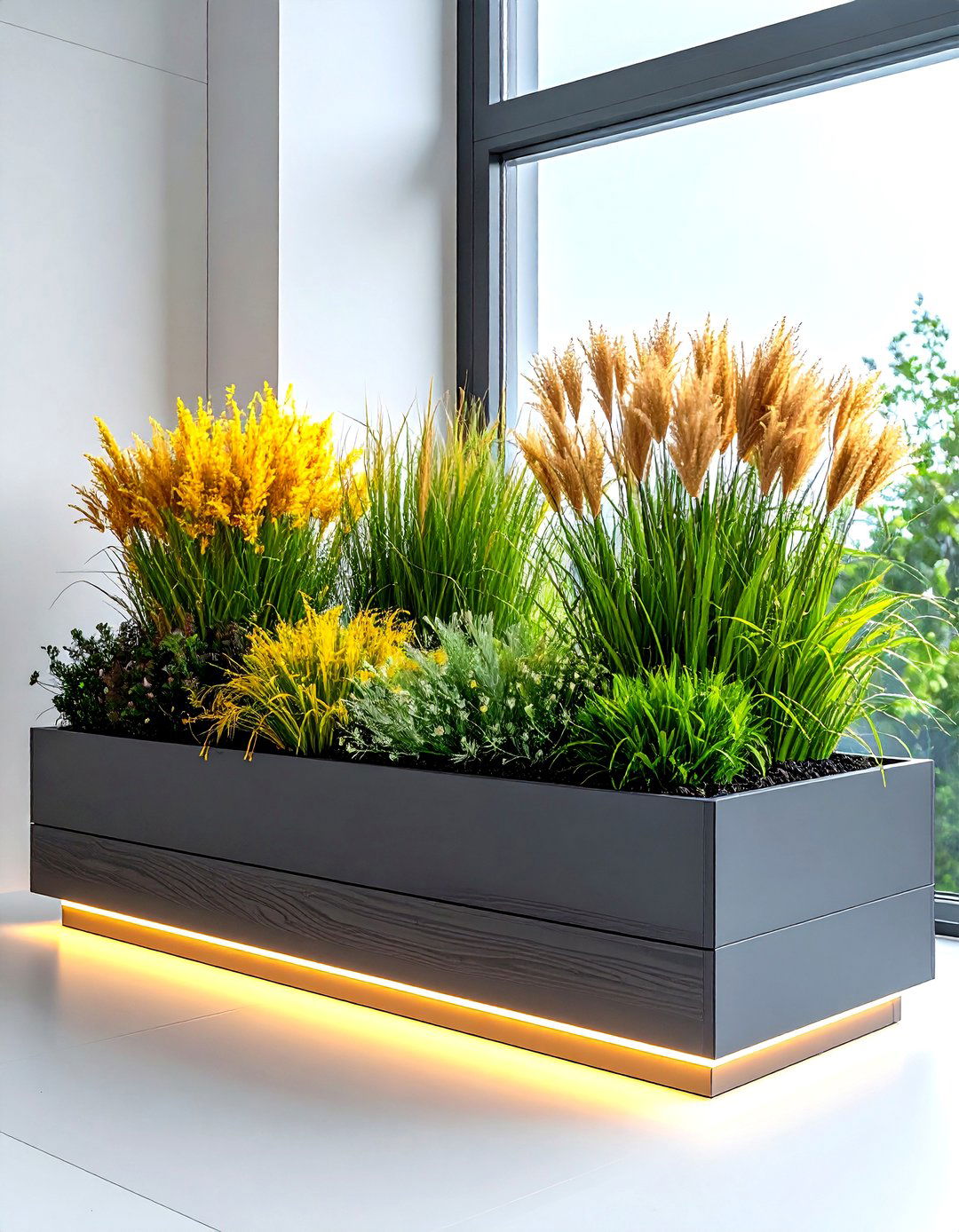
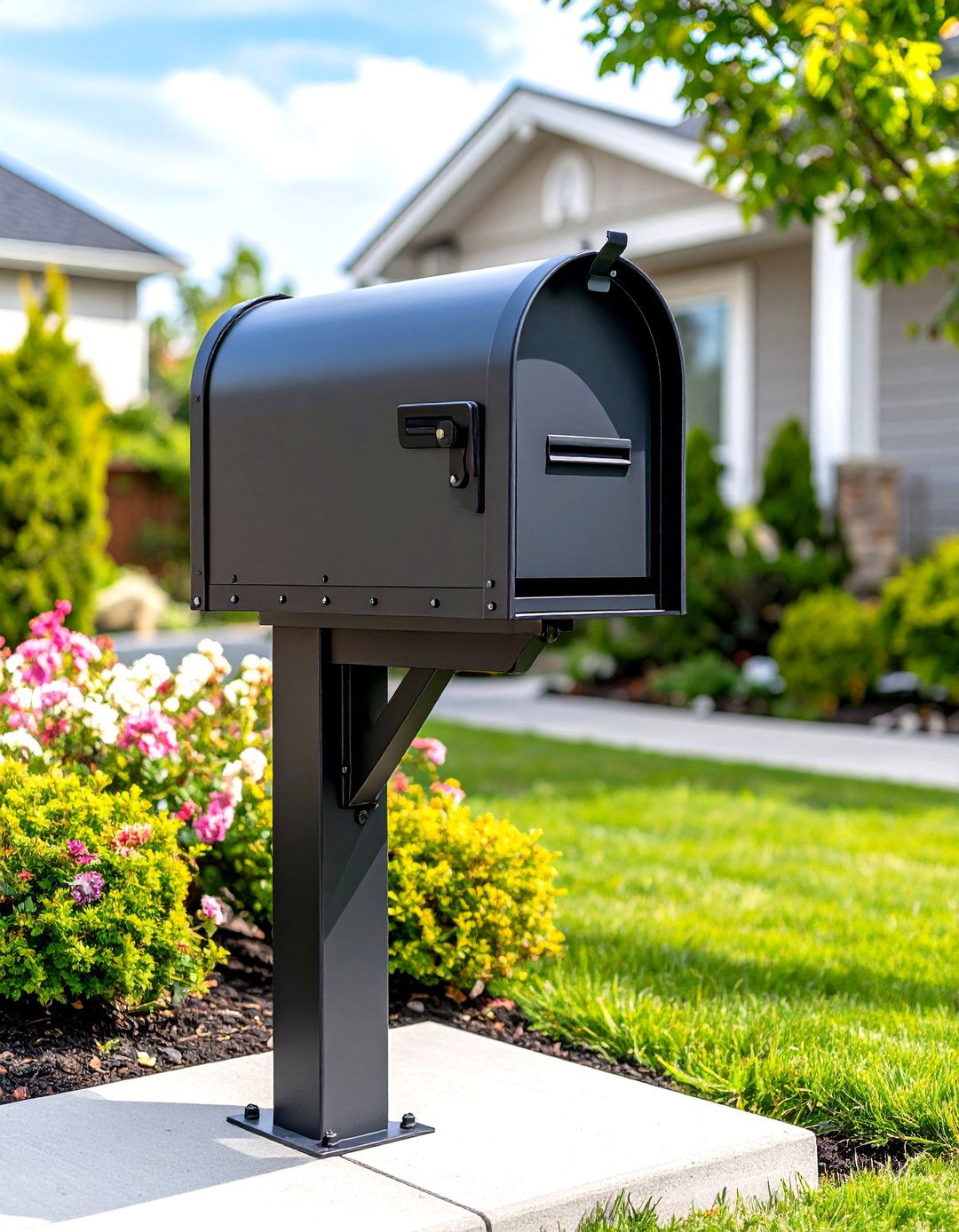

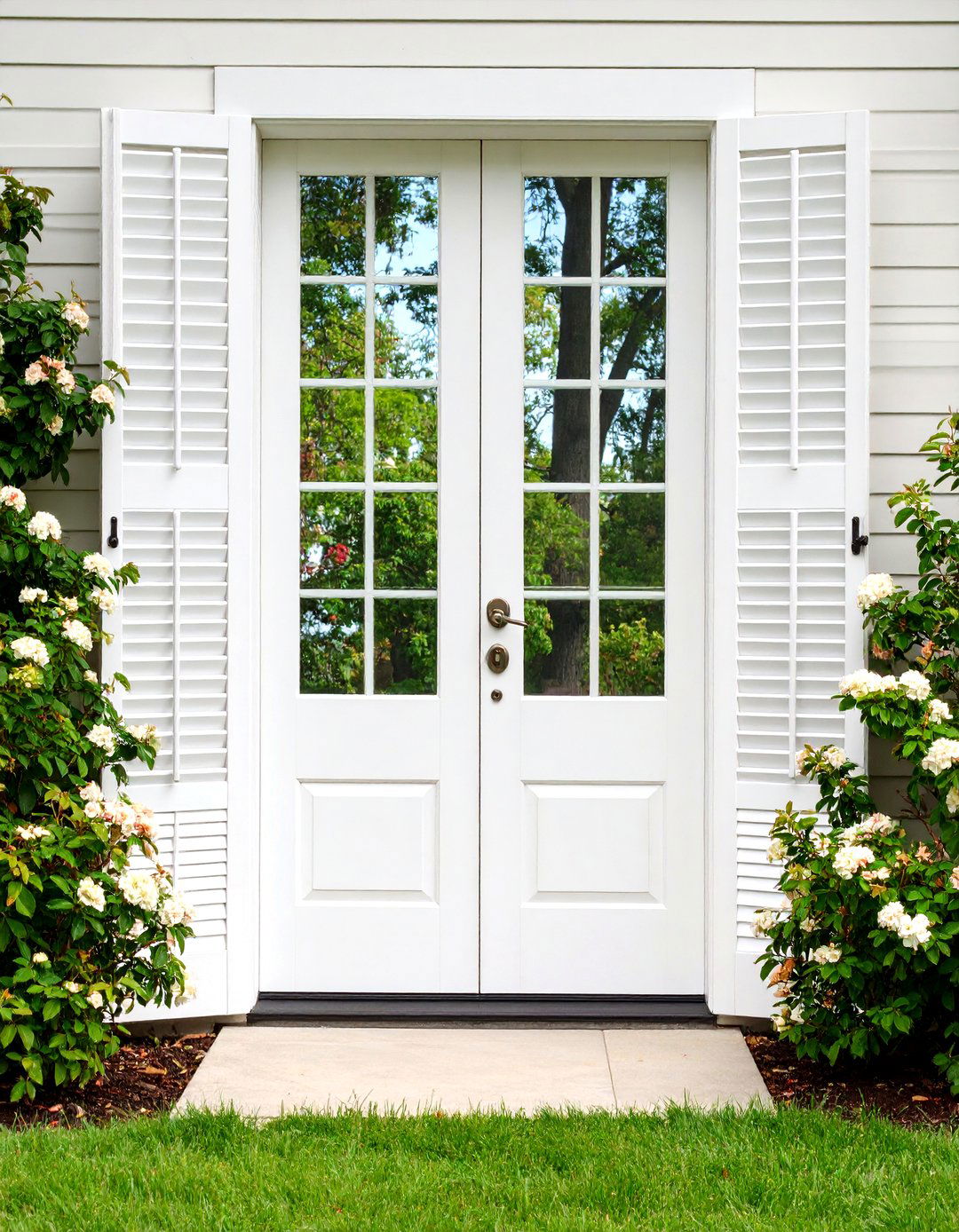
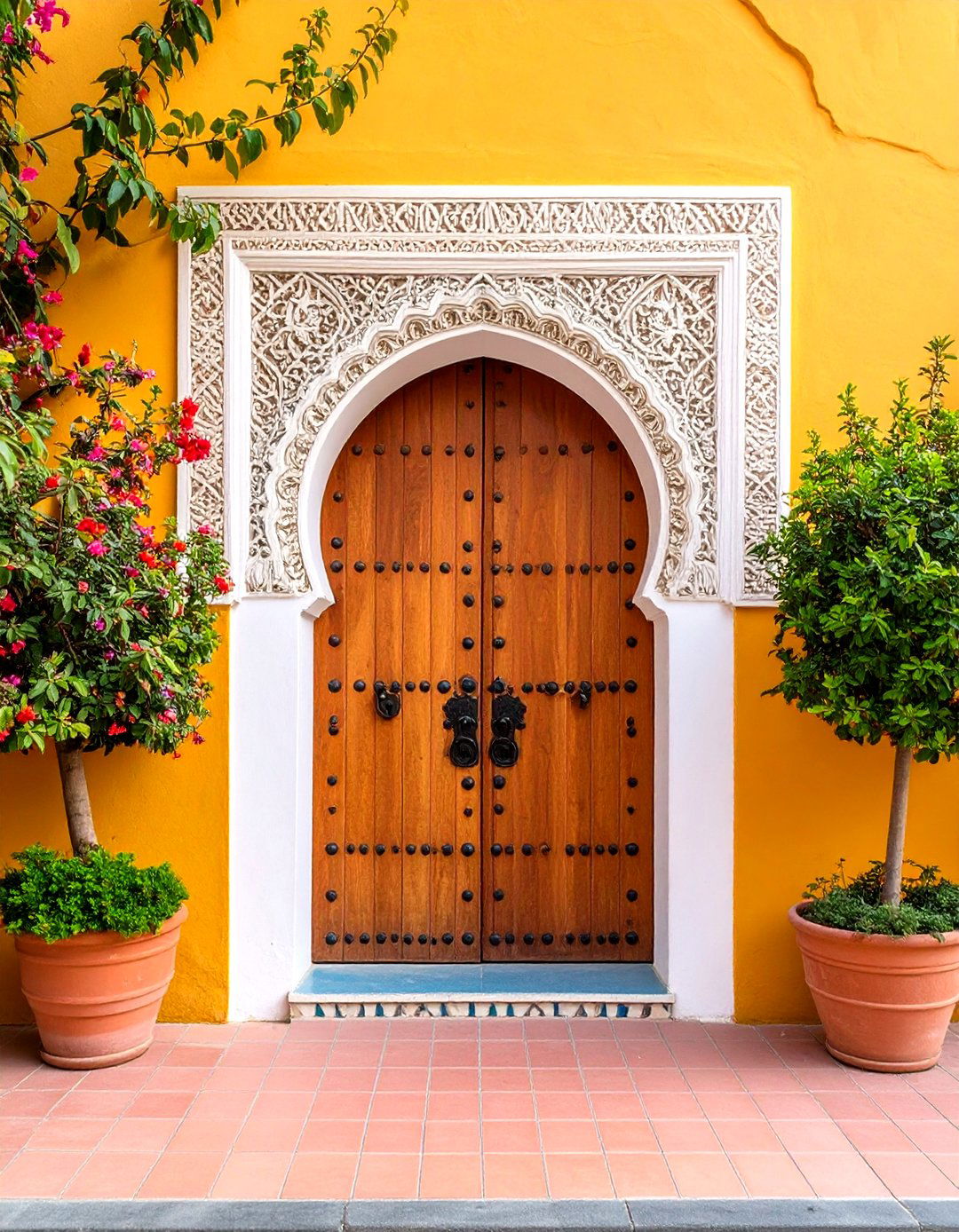
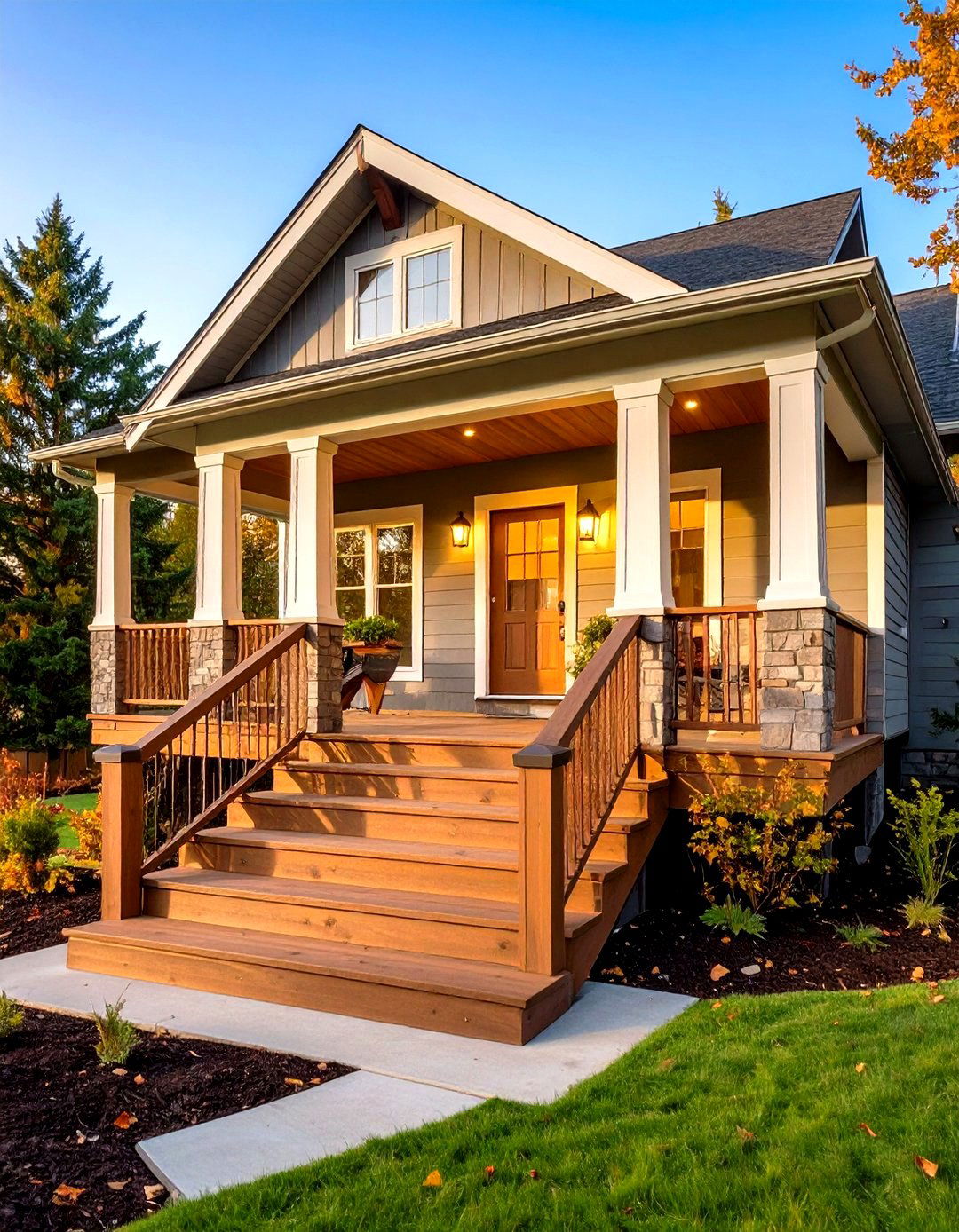
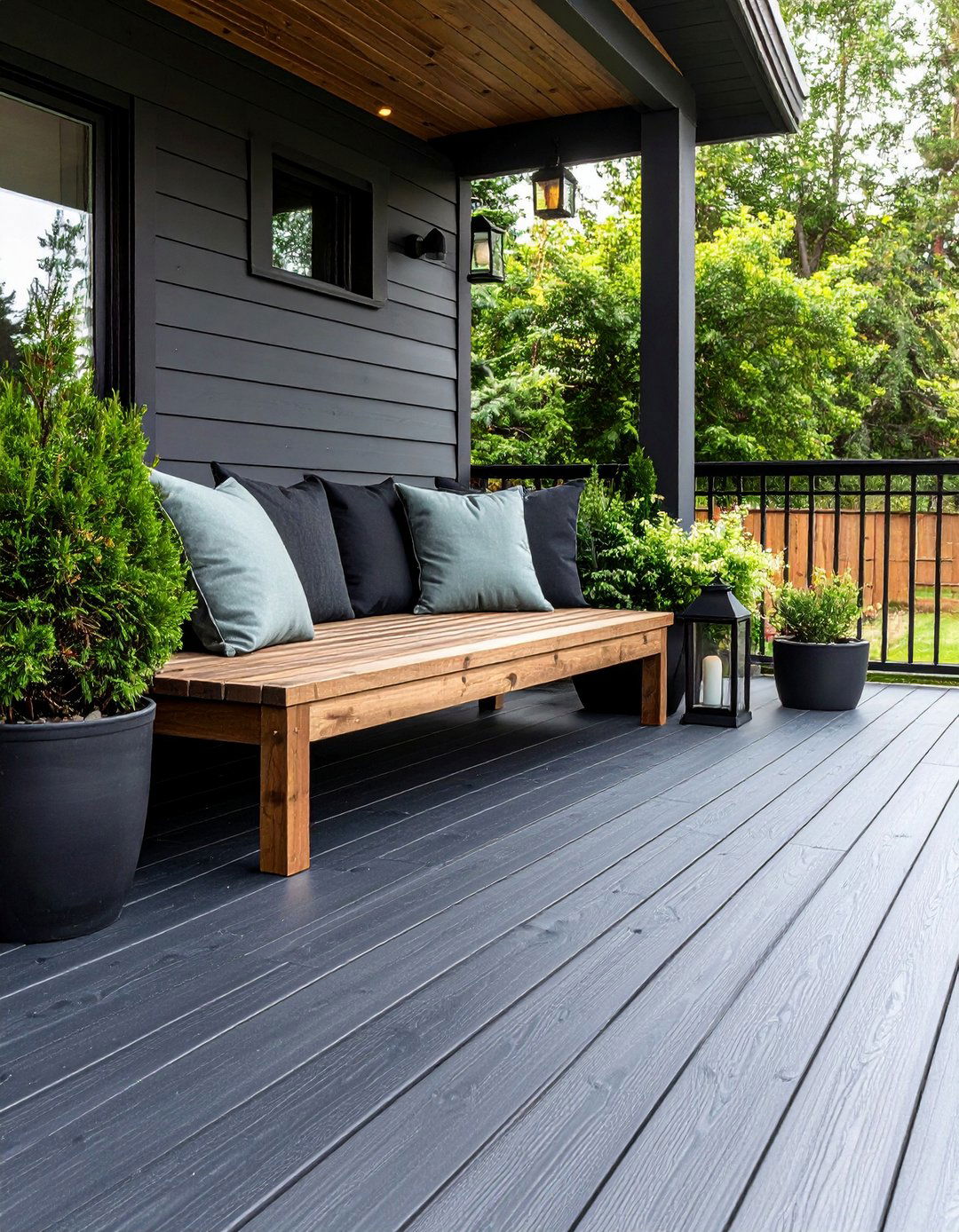
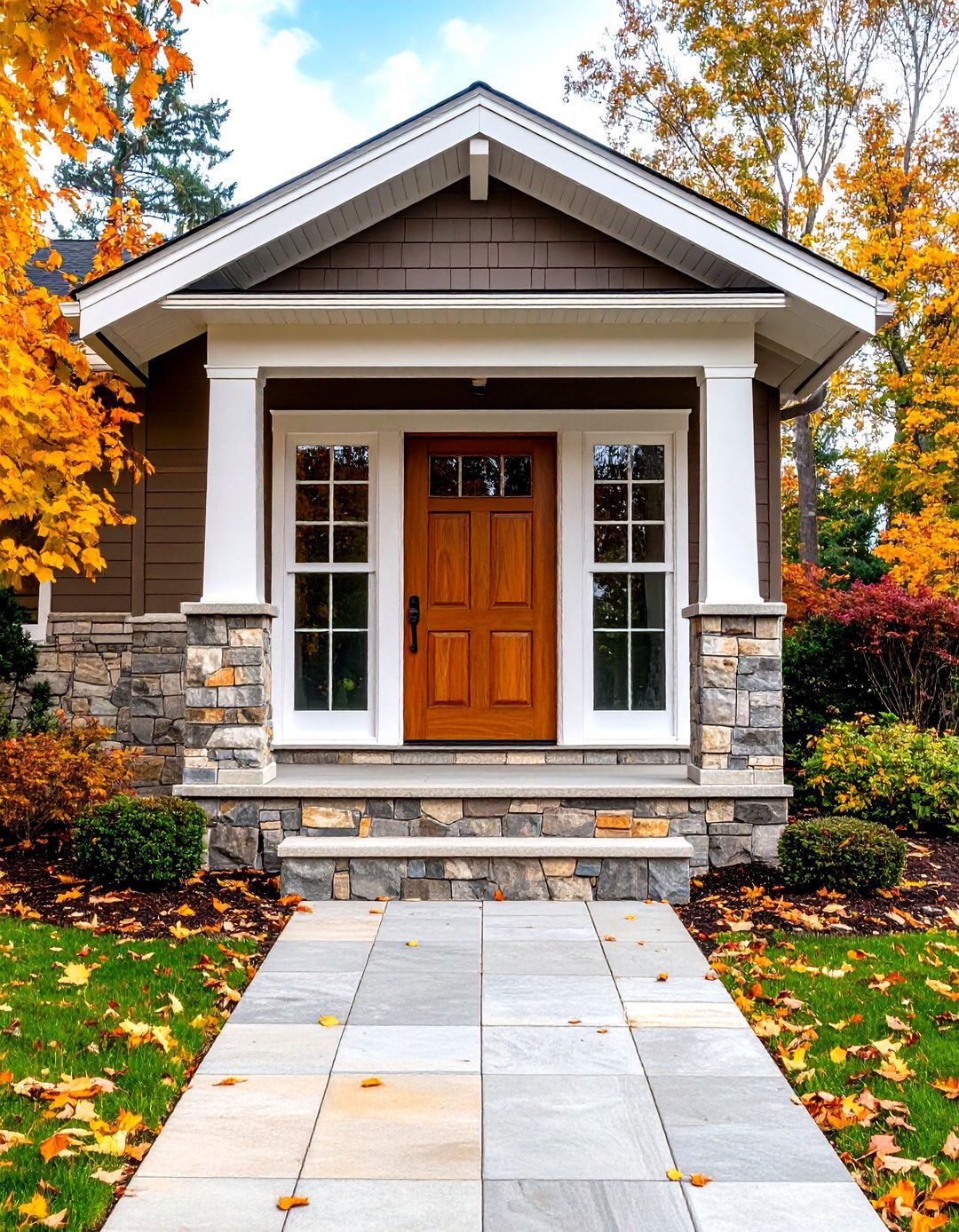
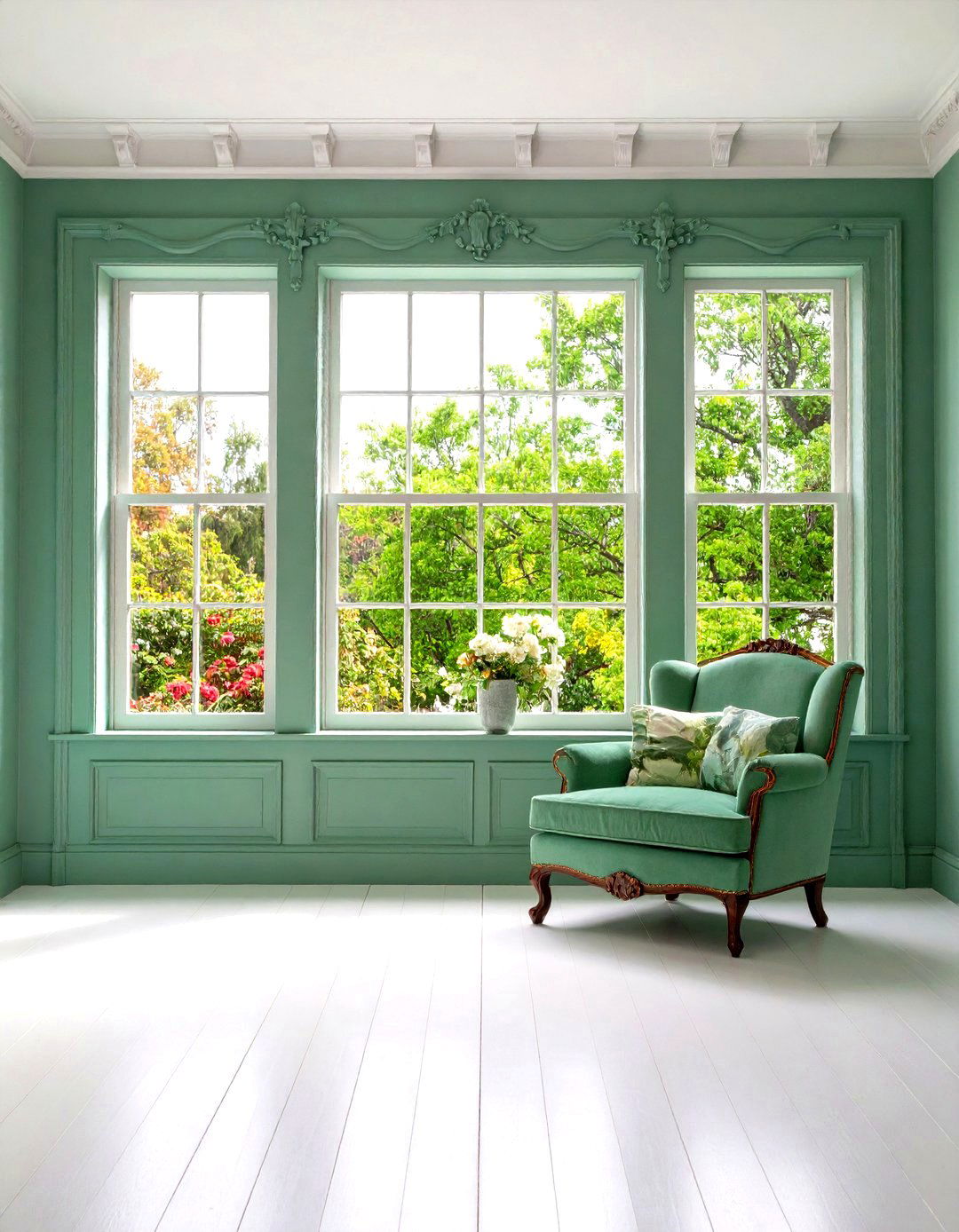

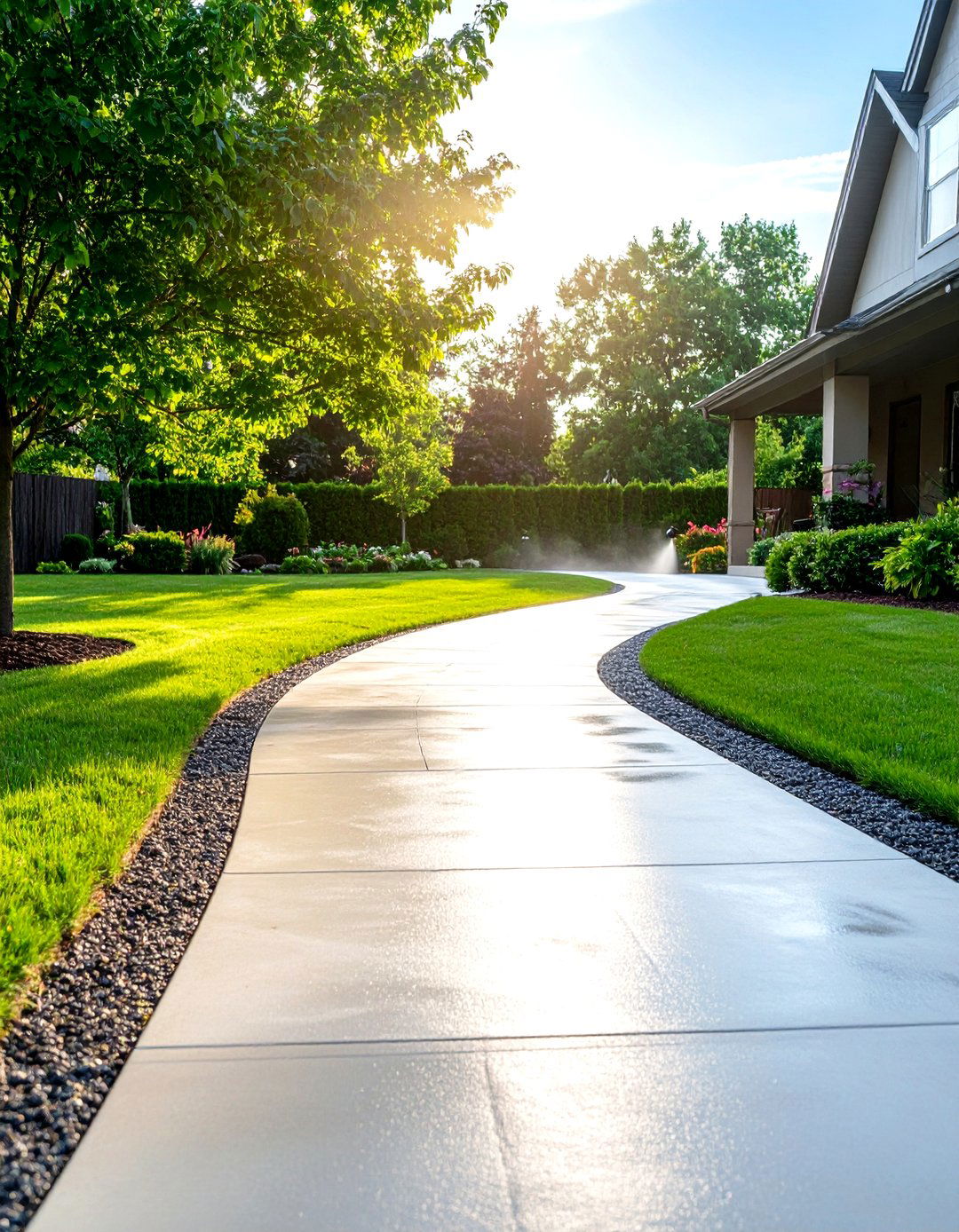
Leave a Reply